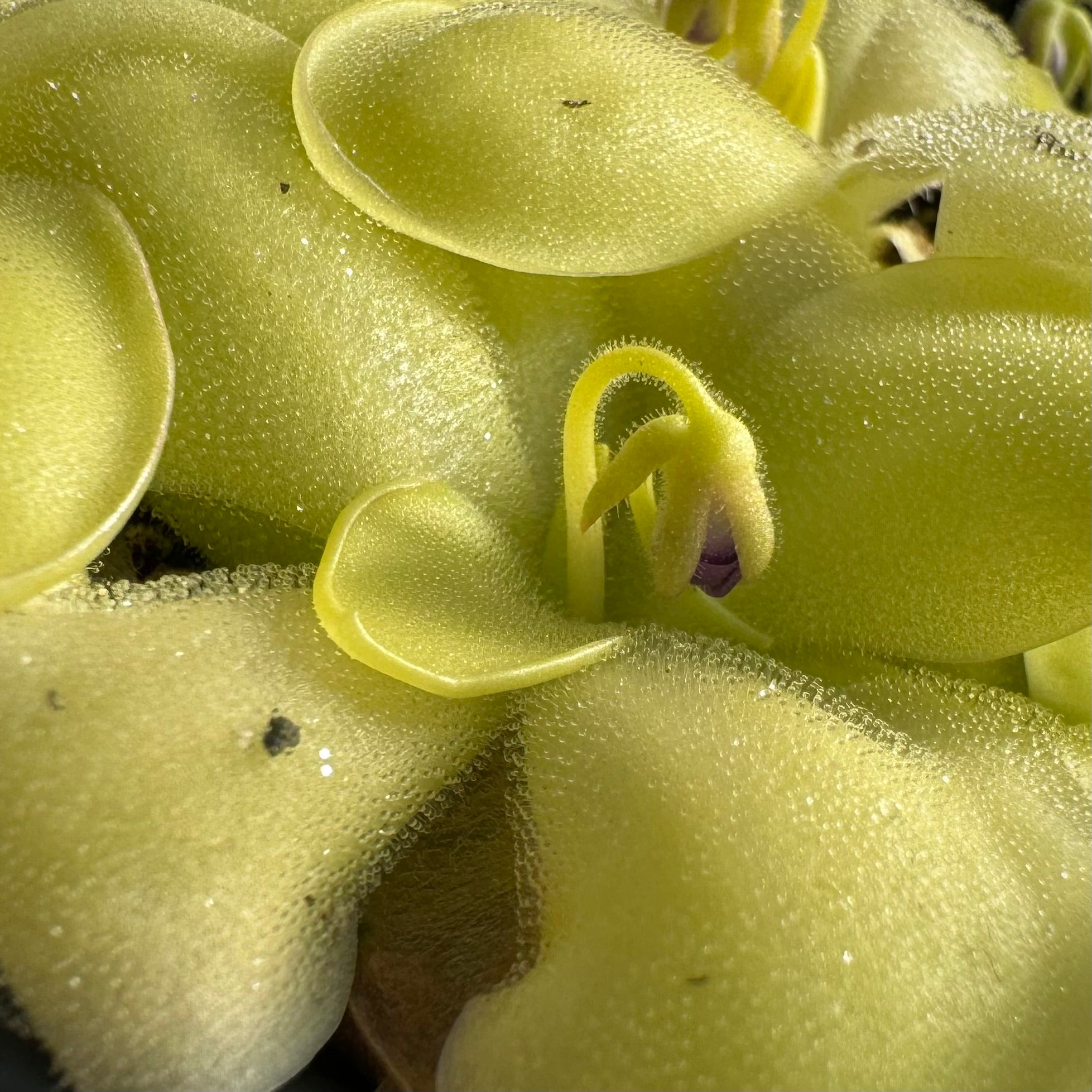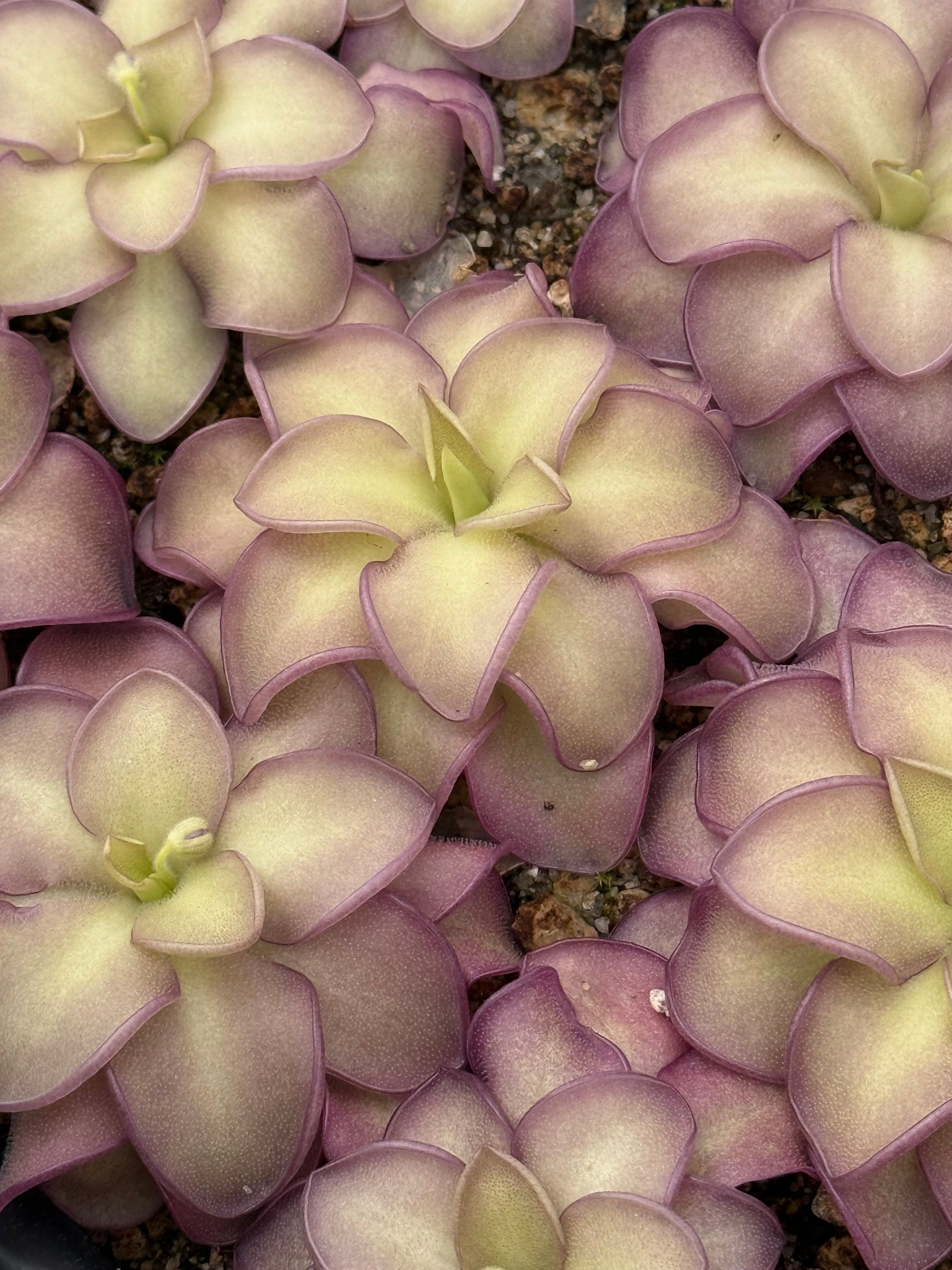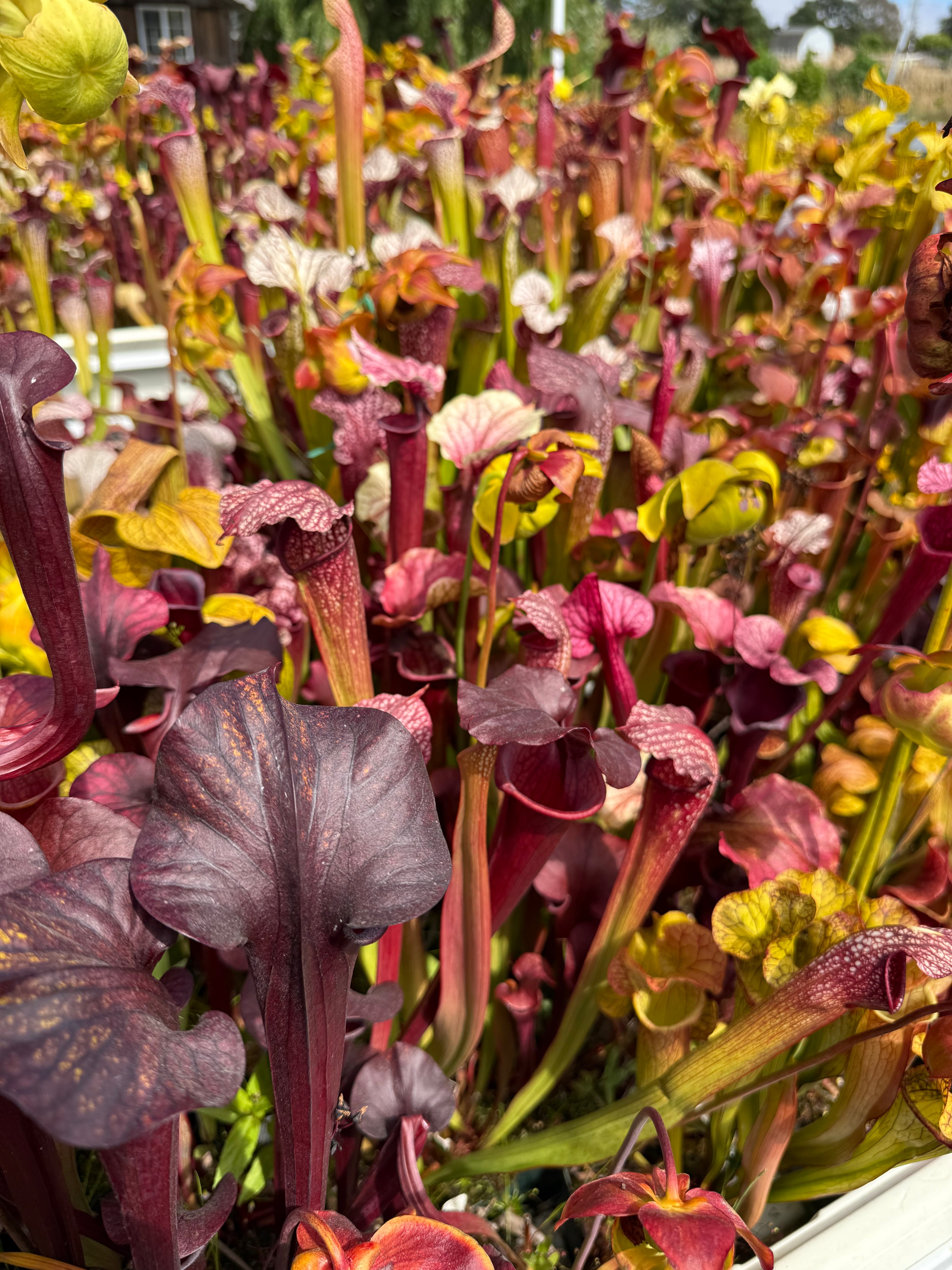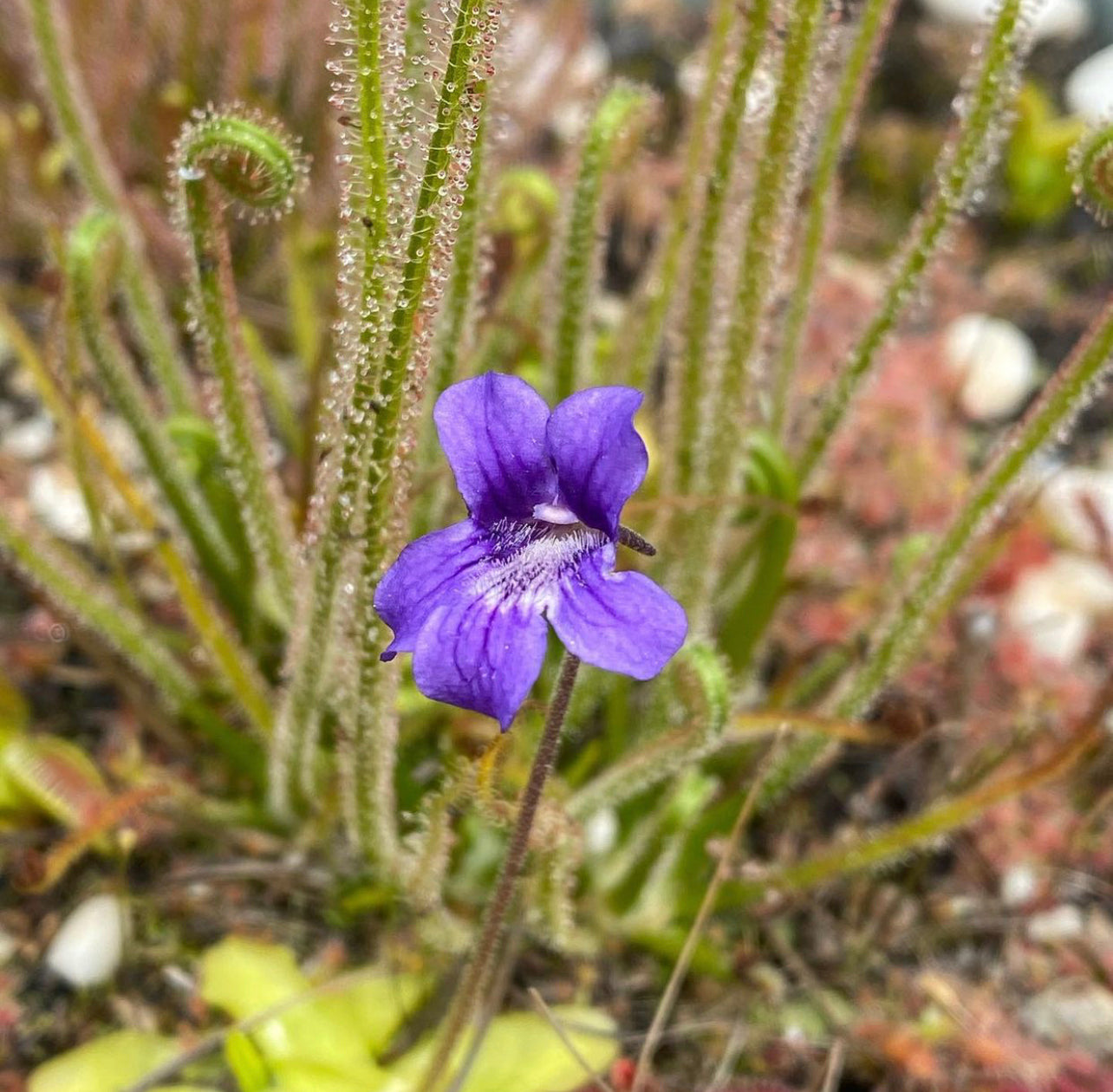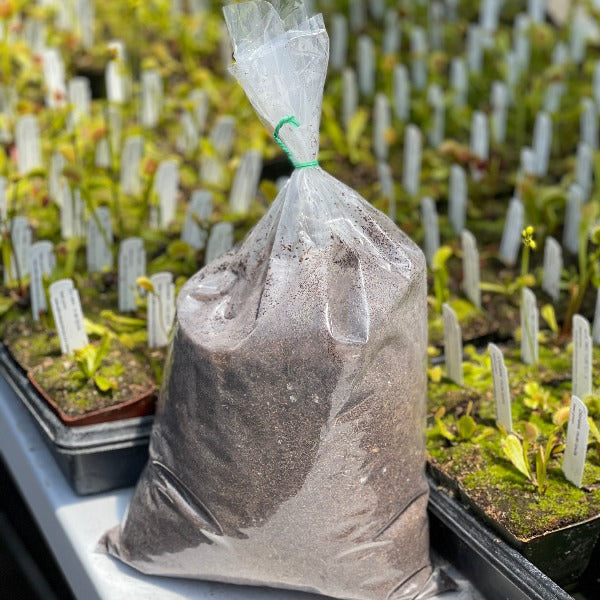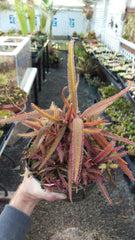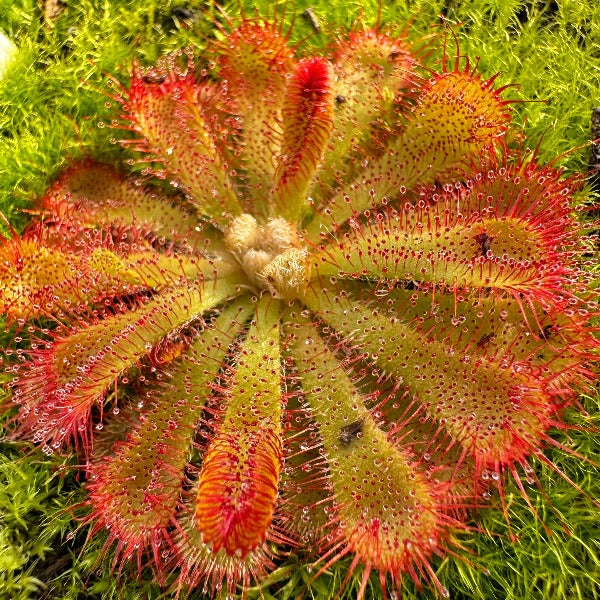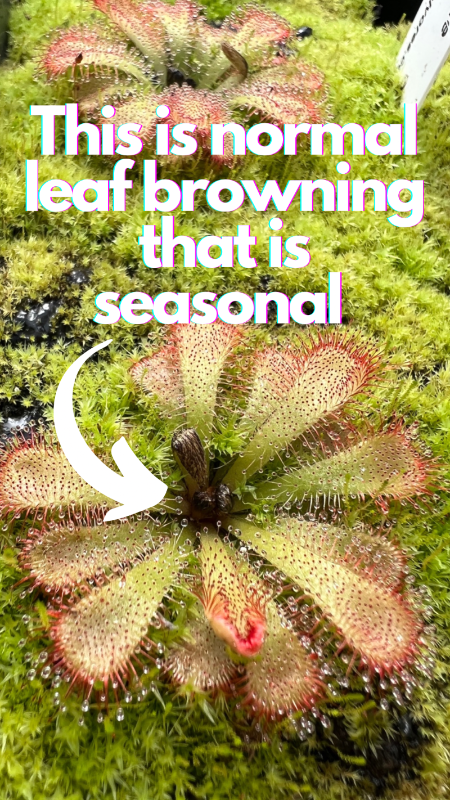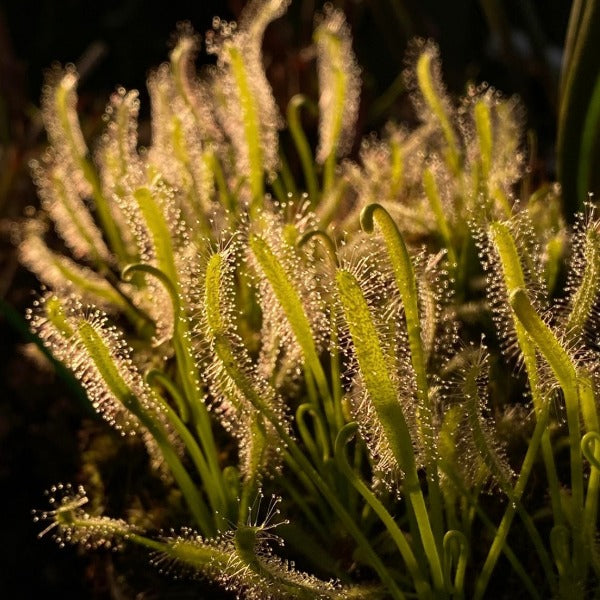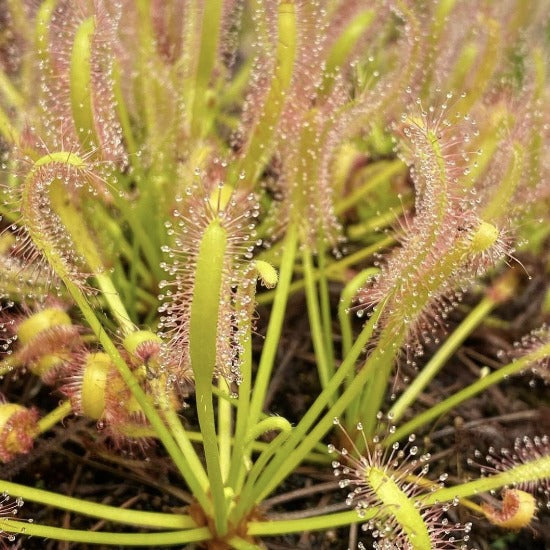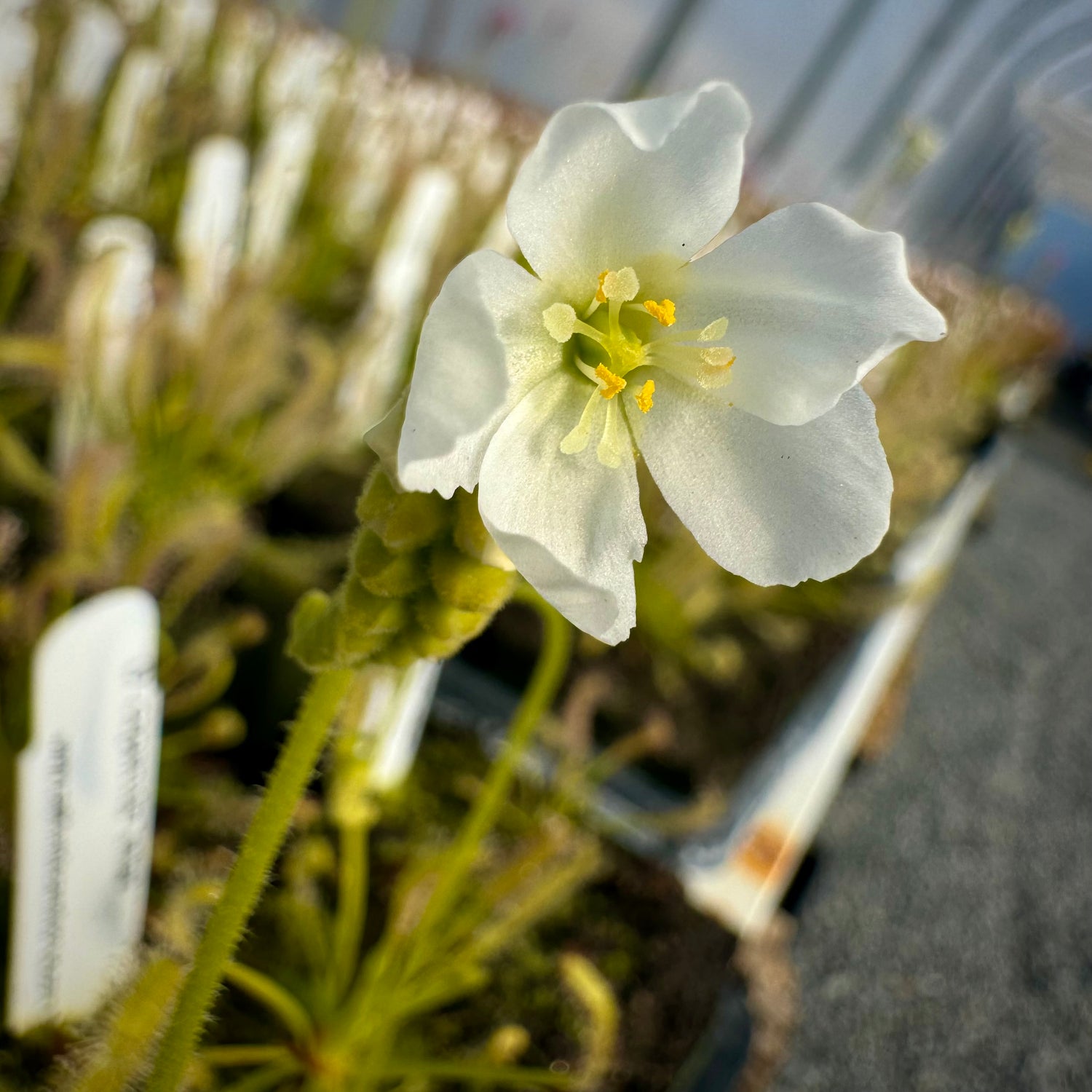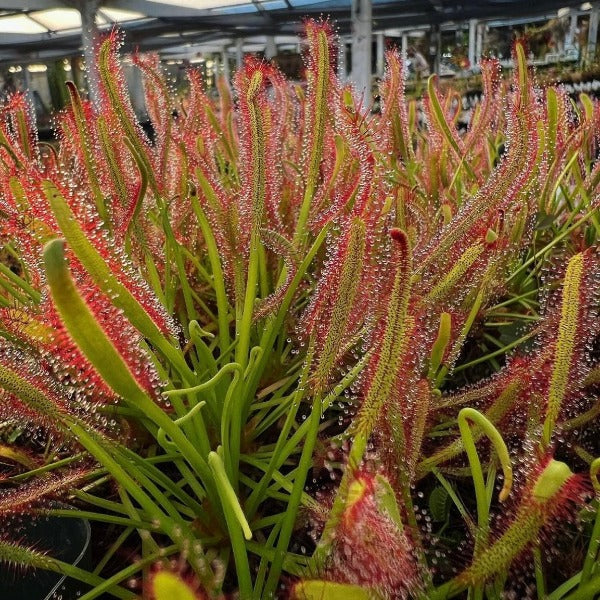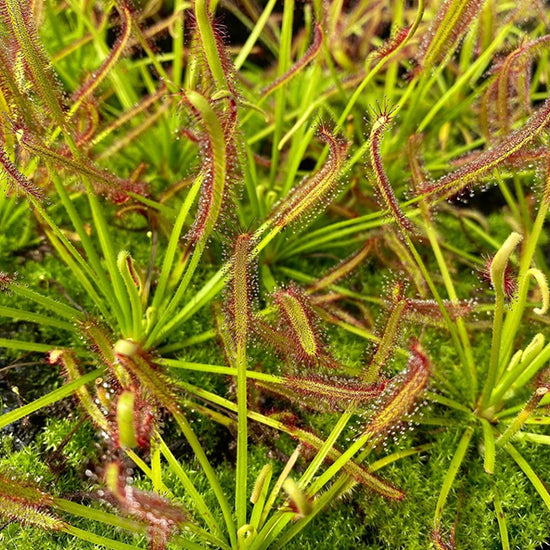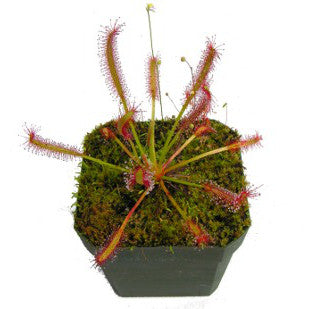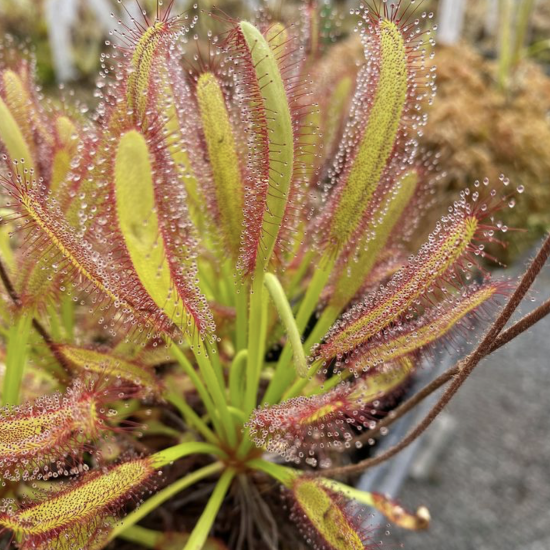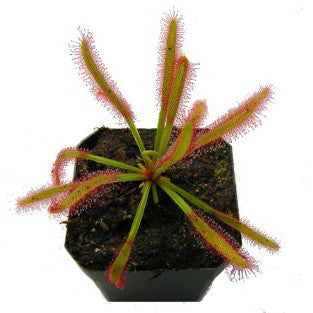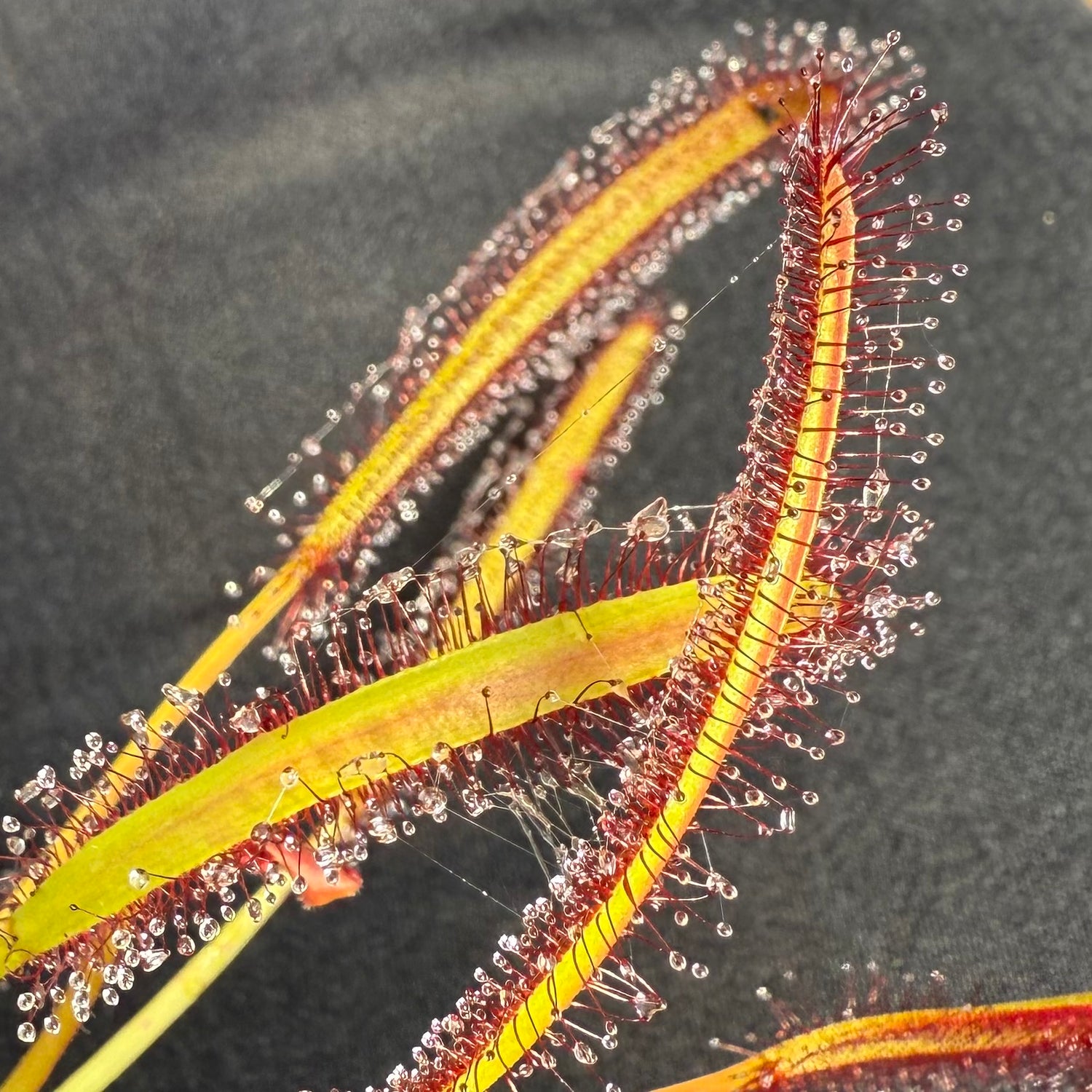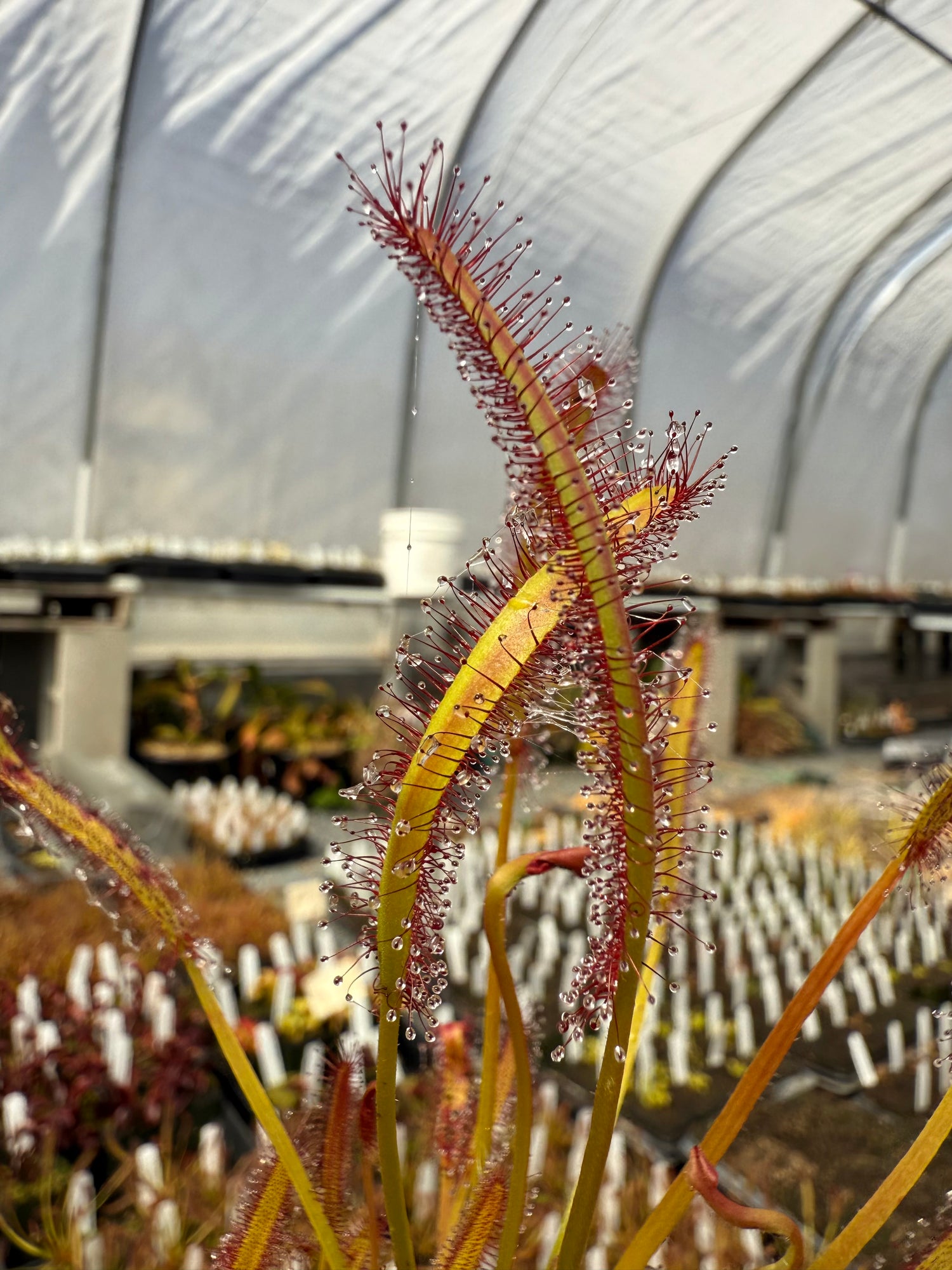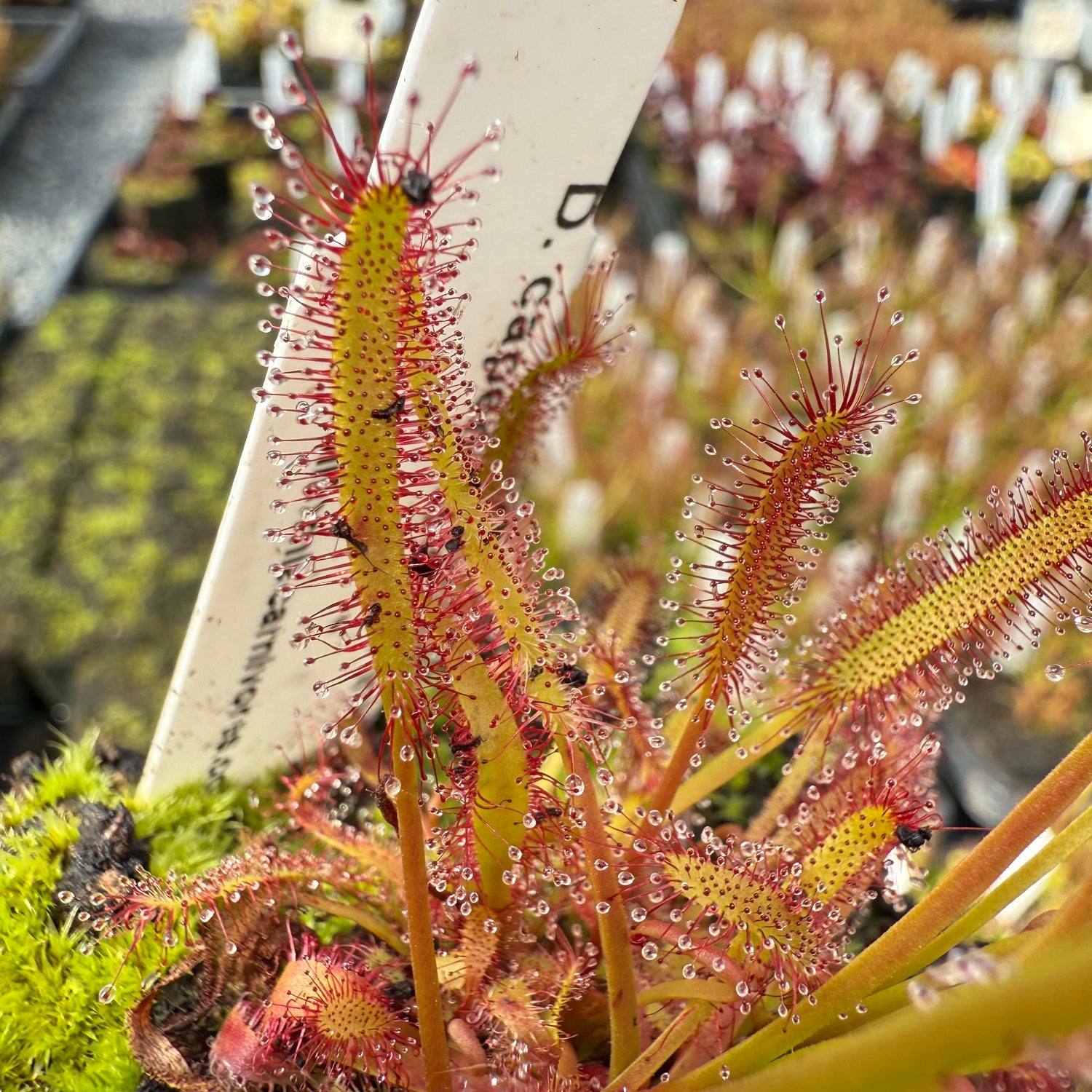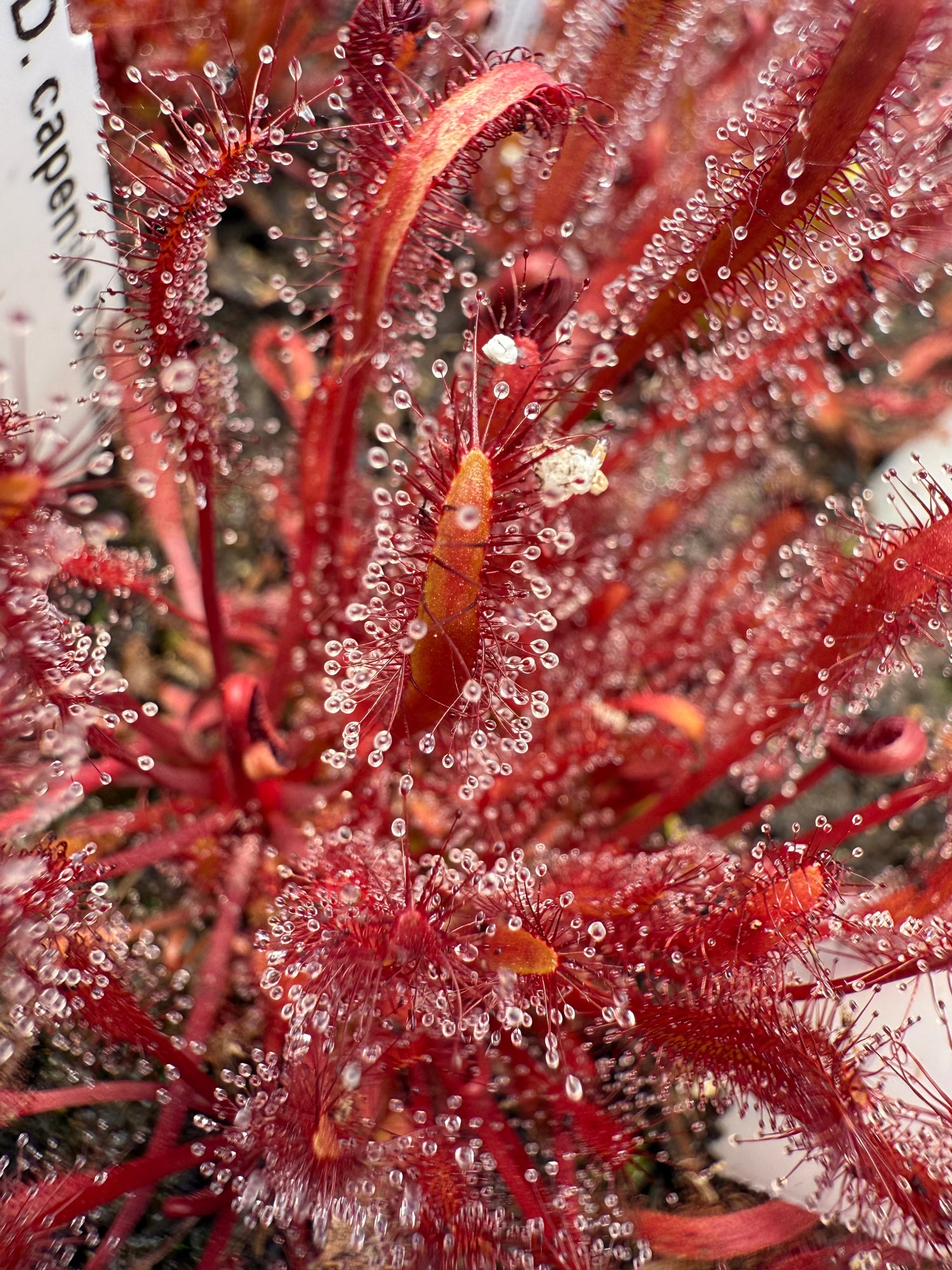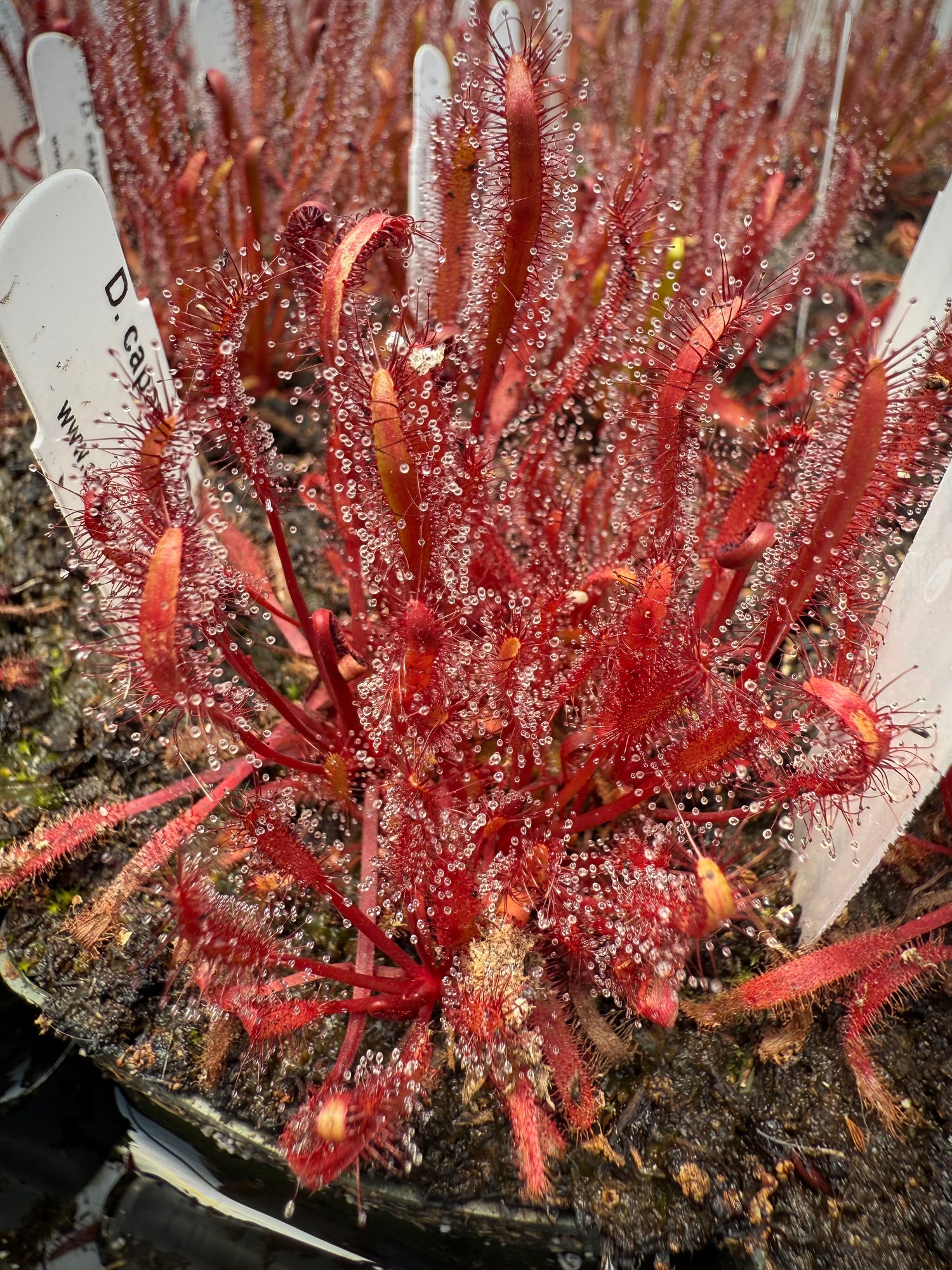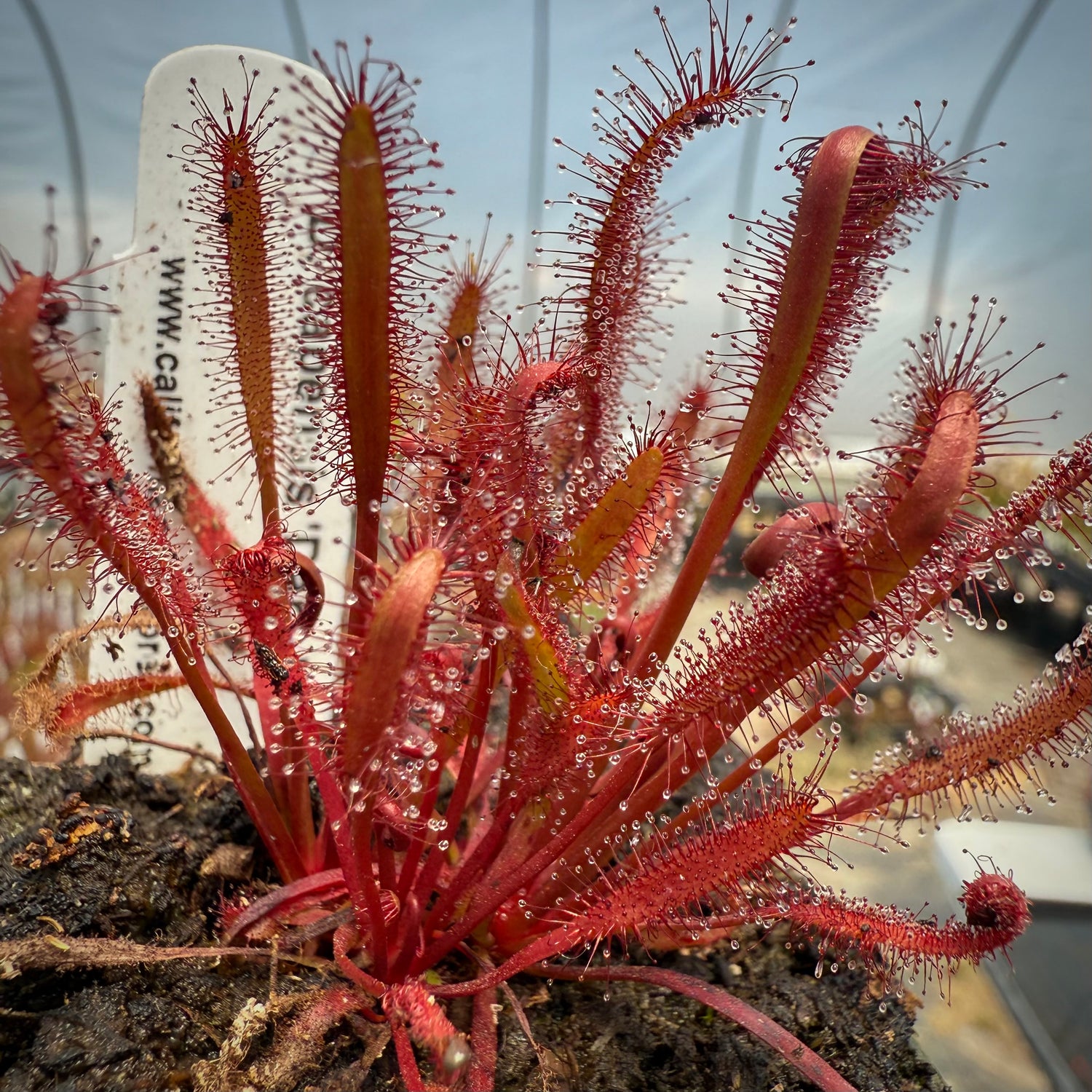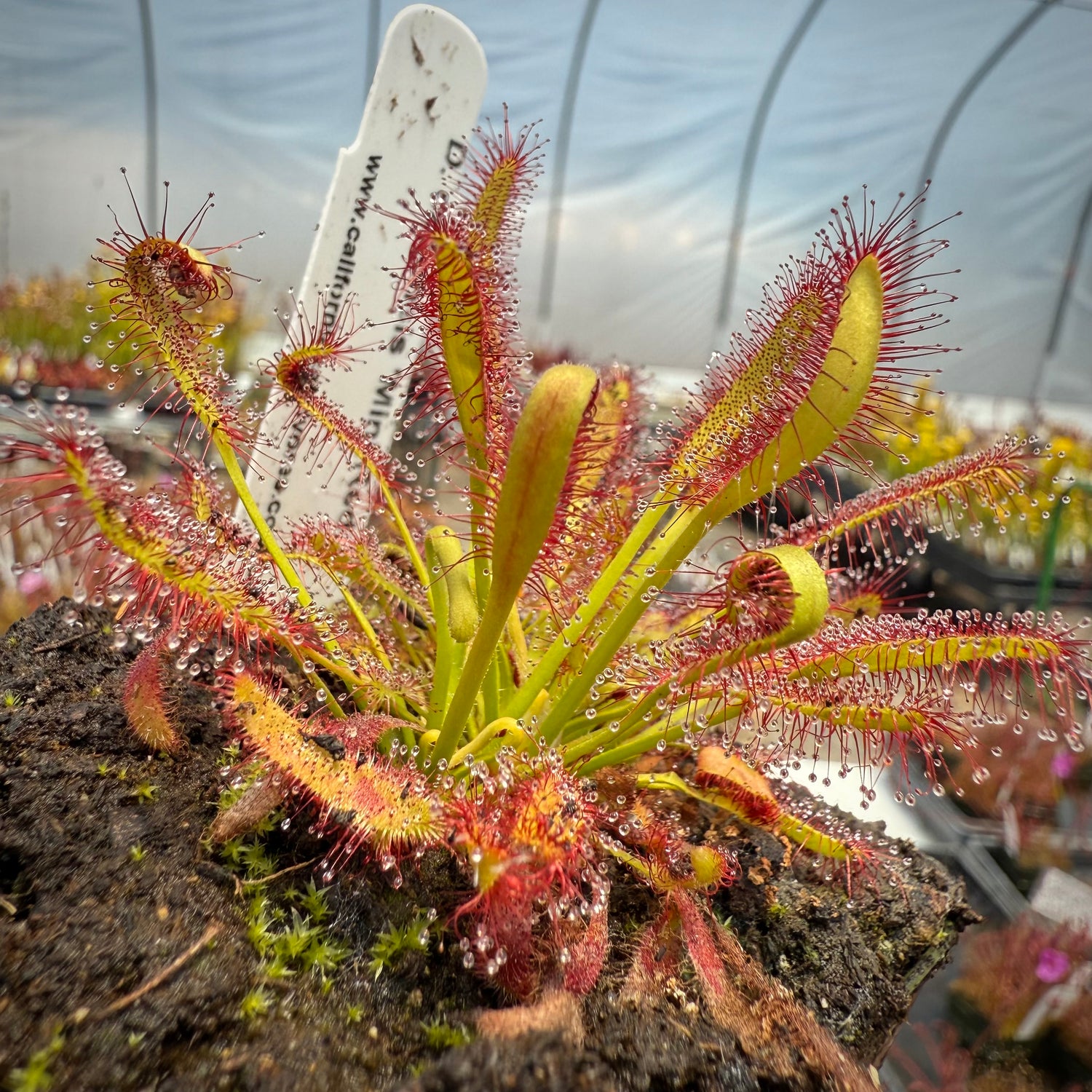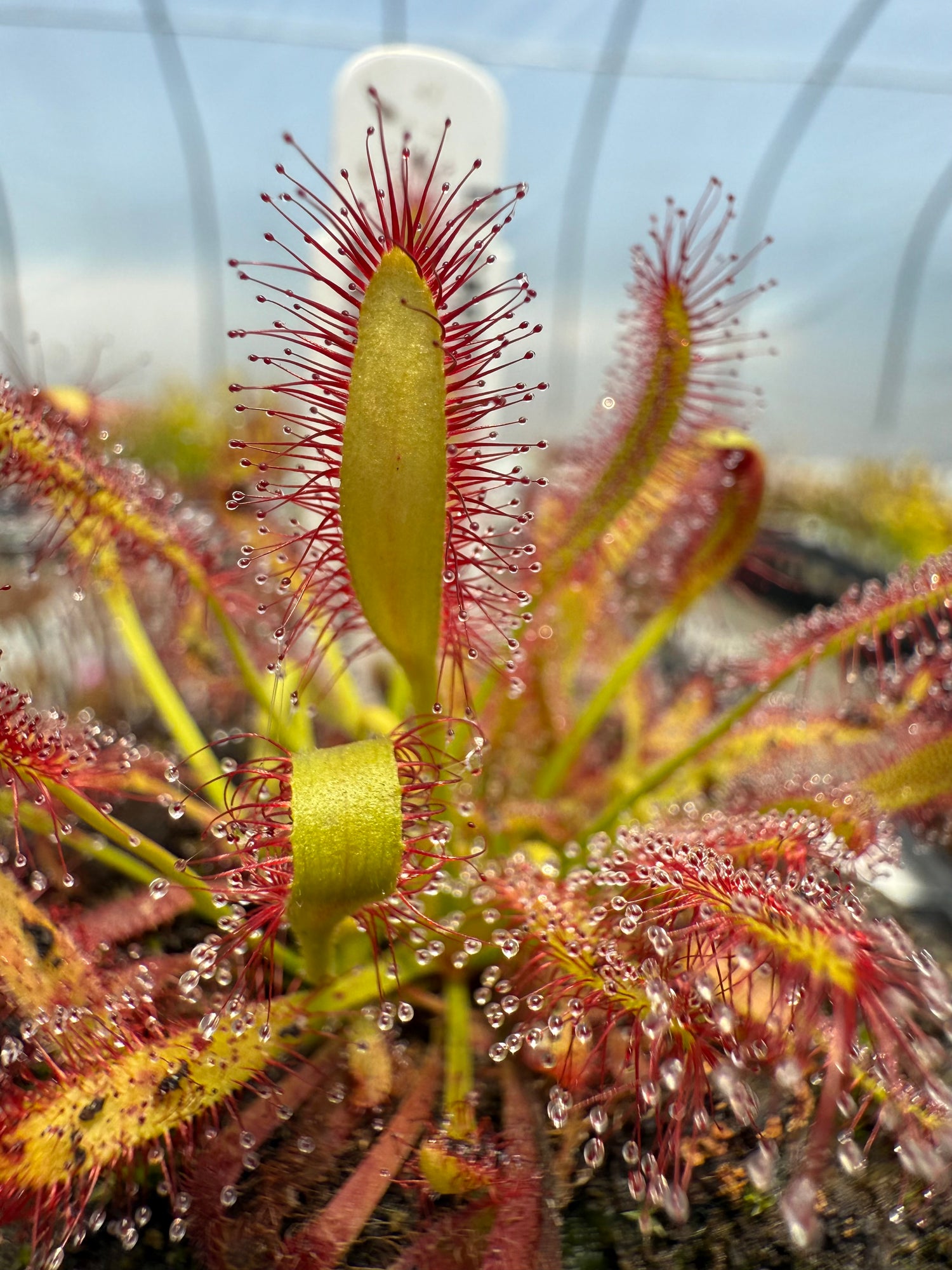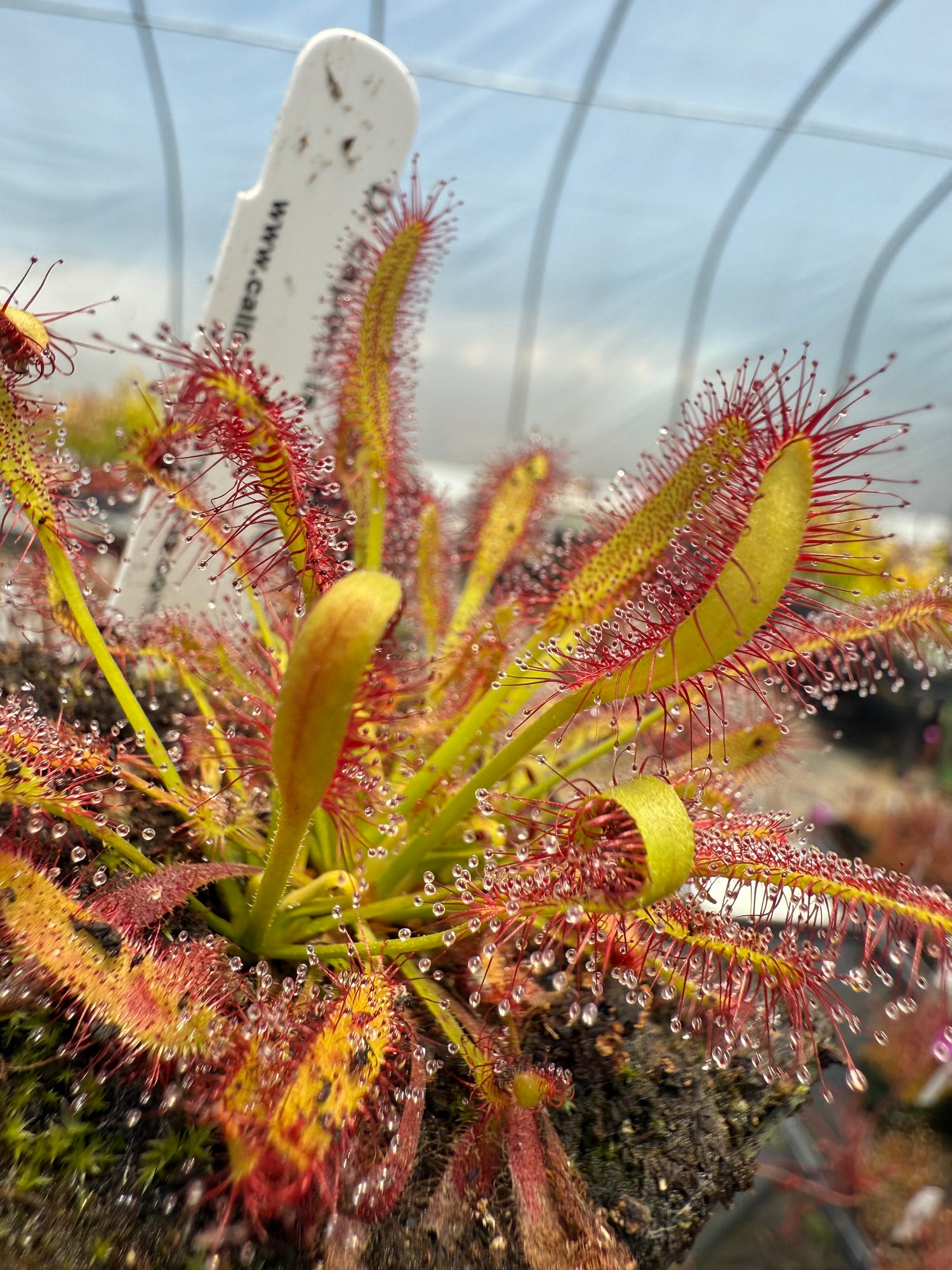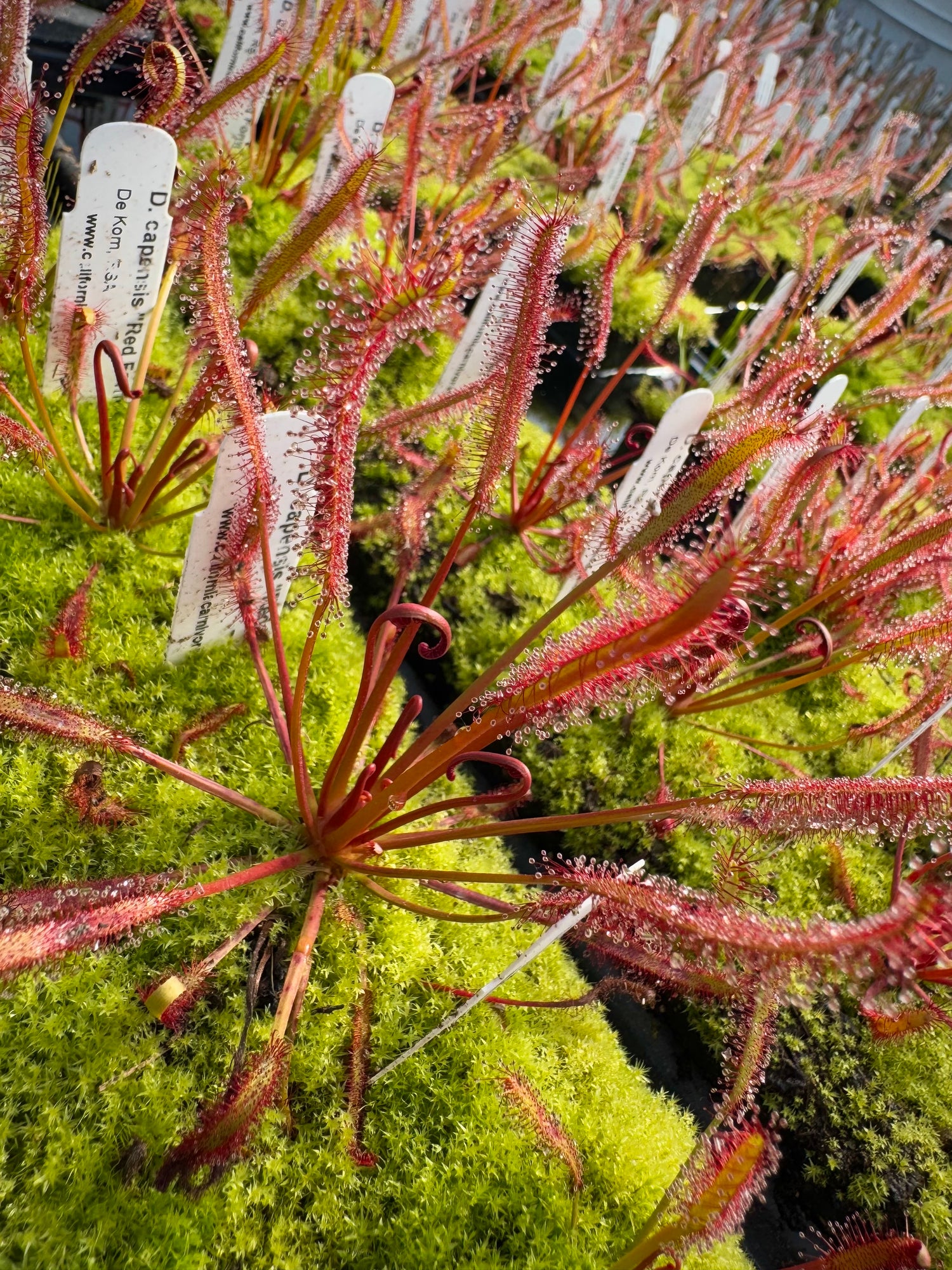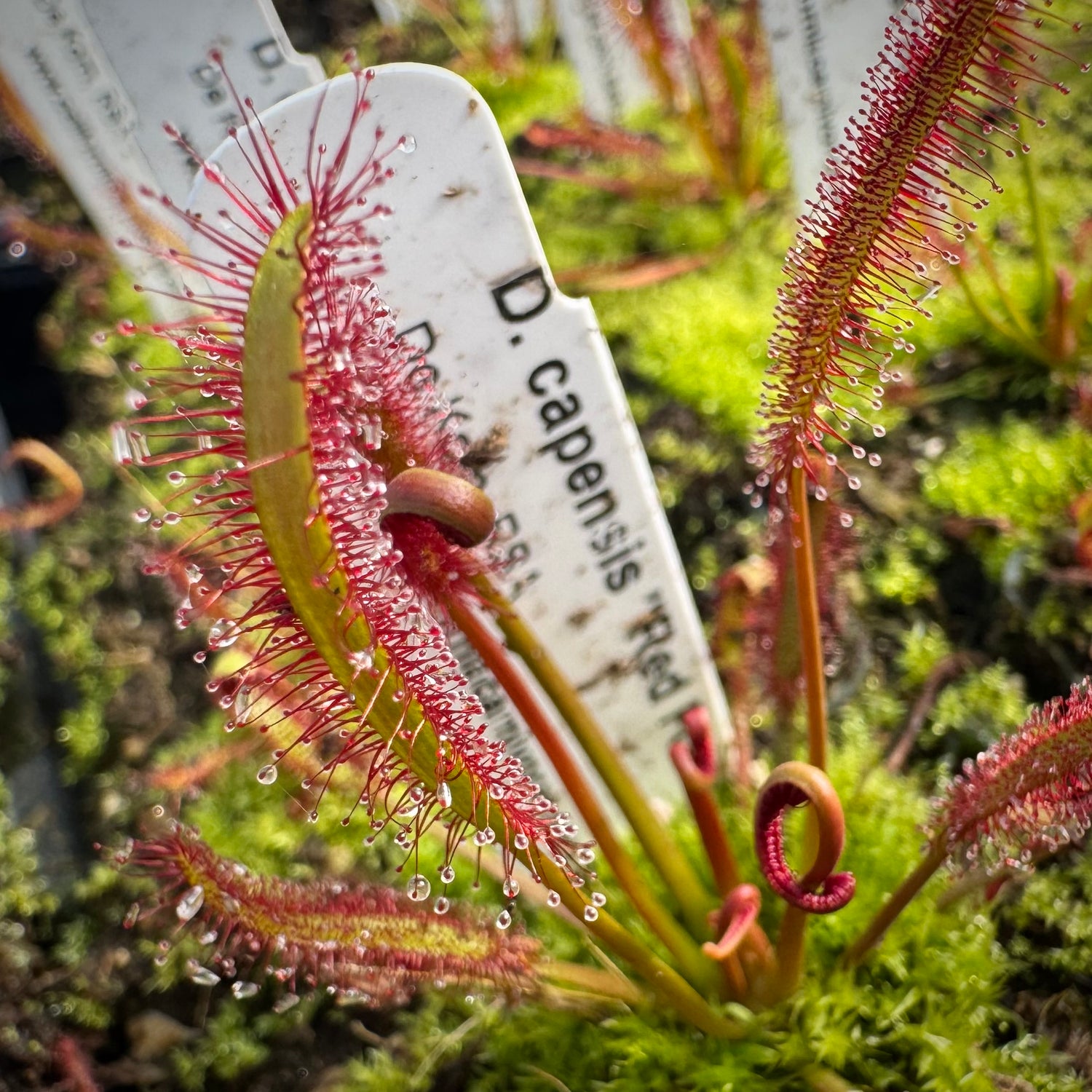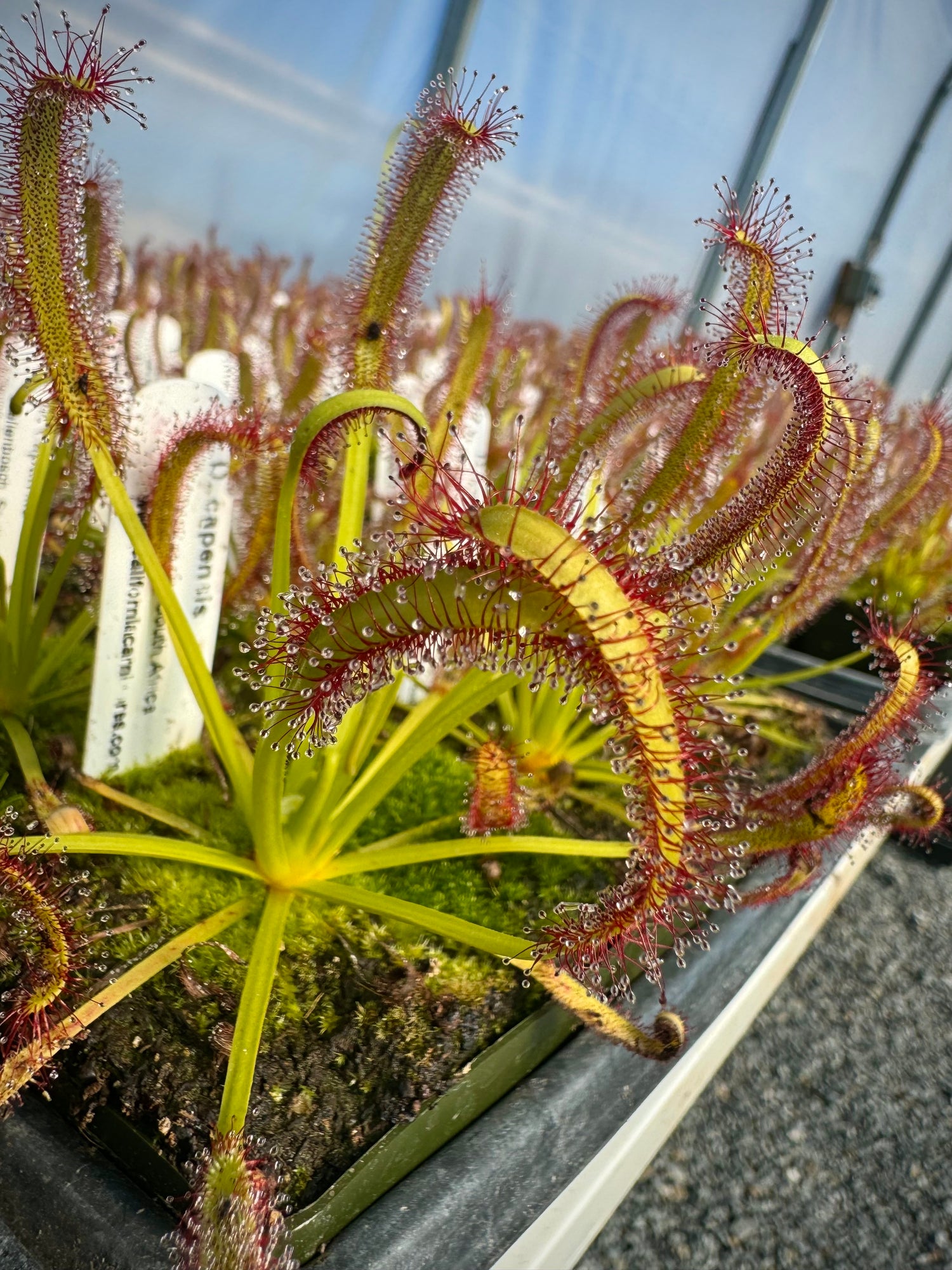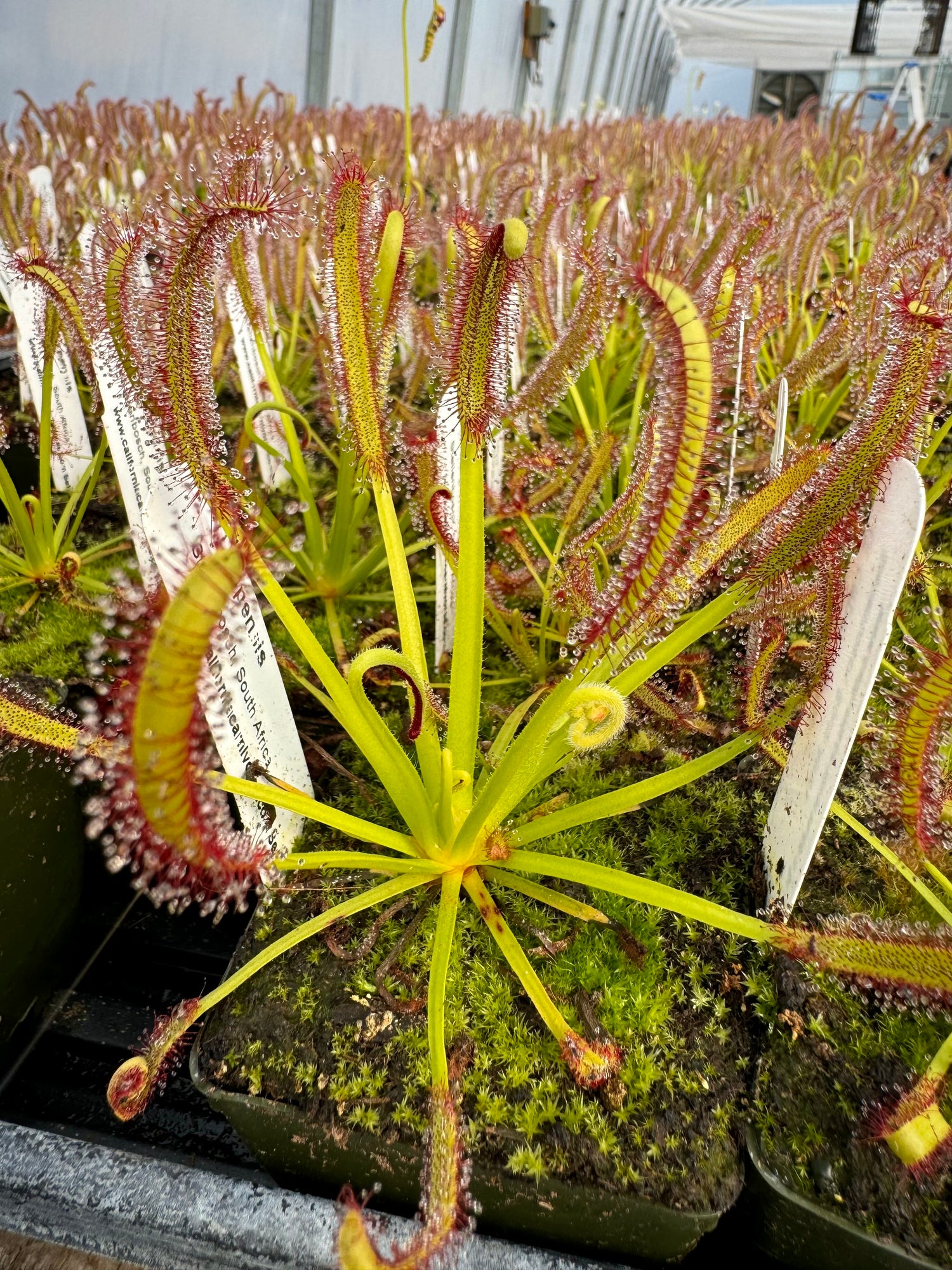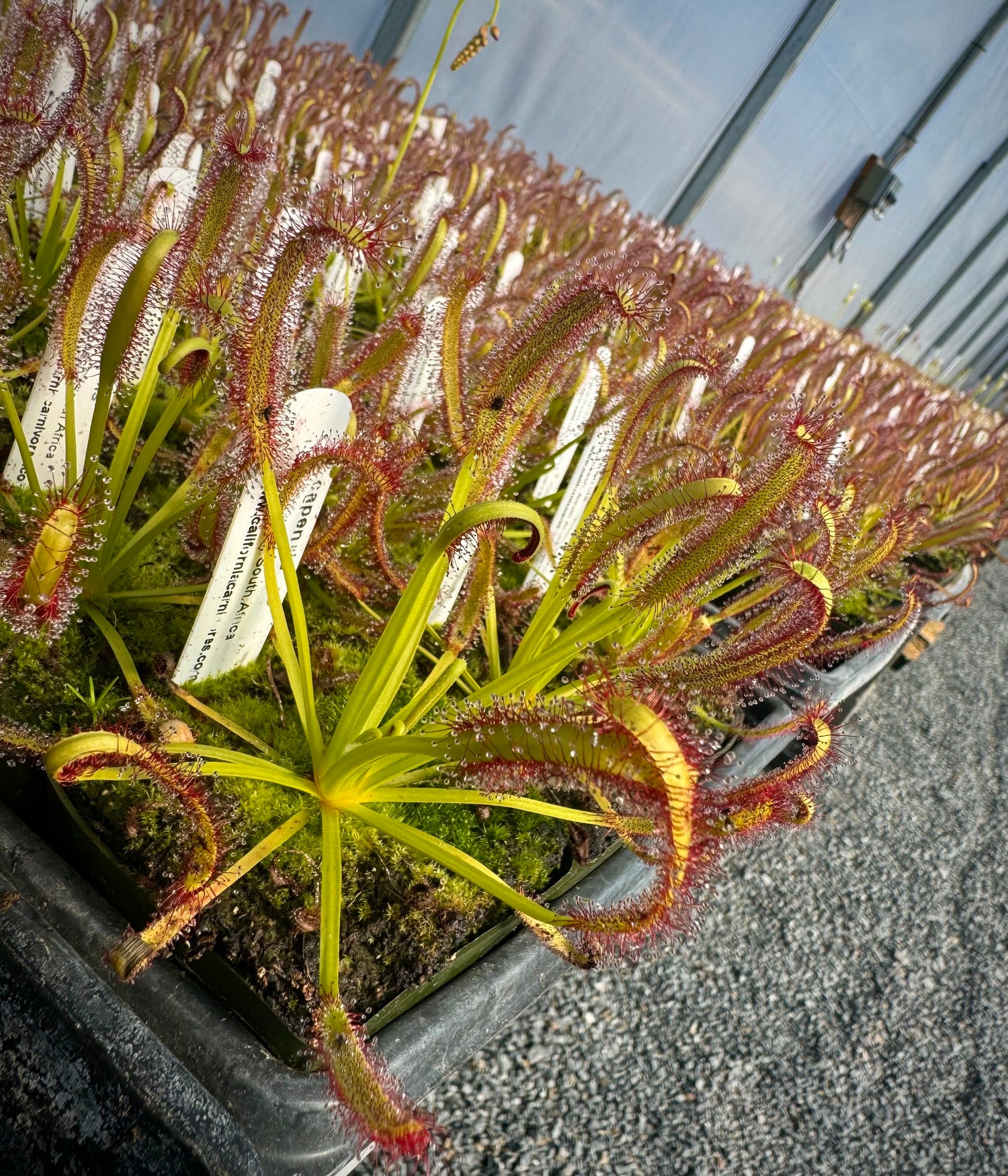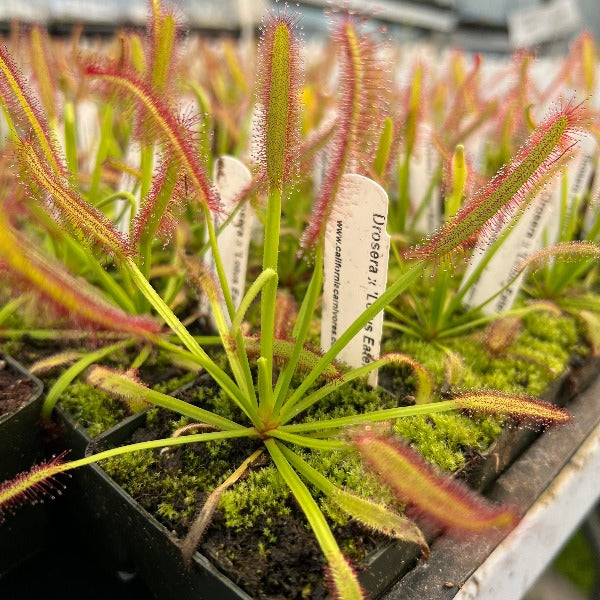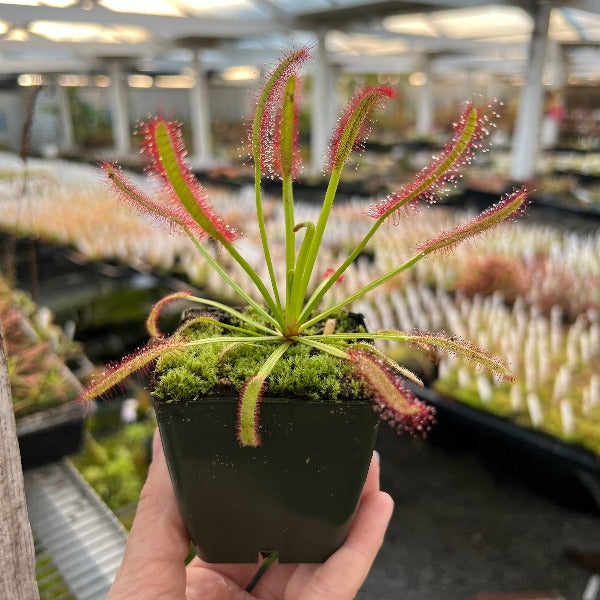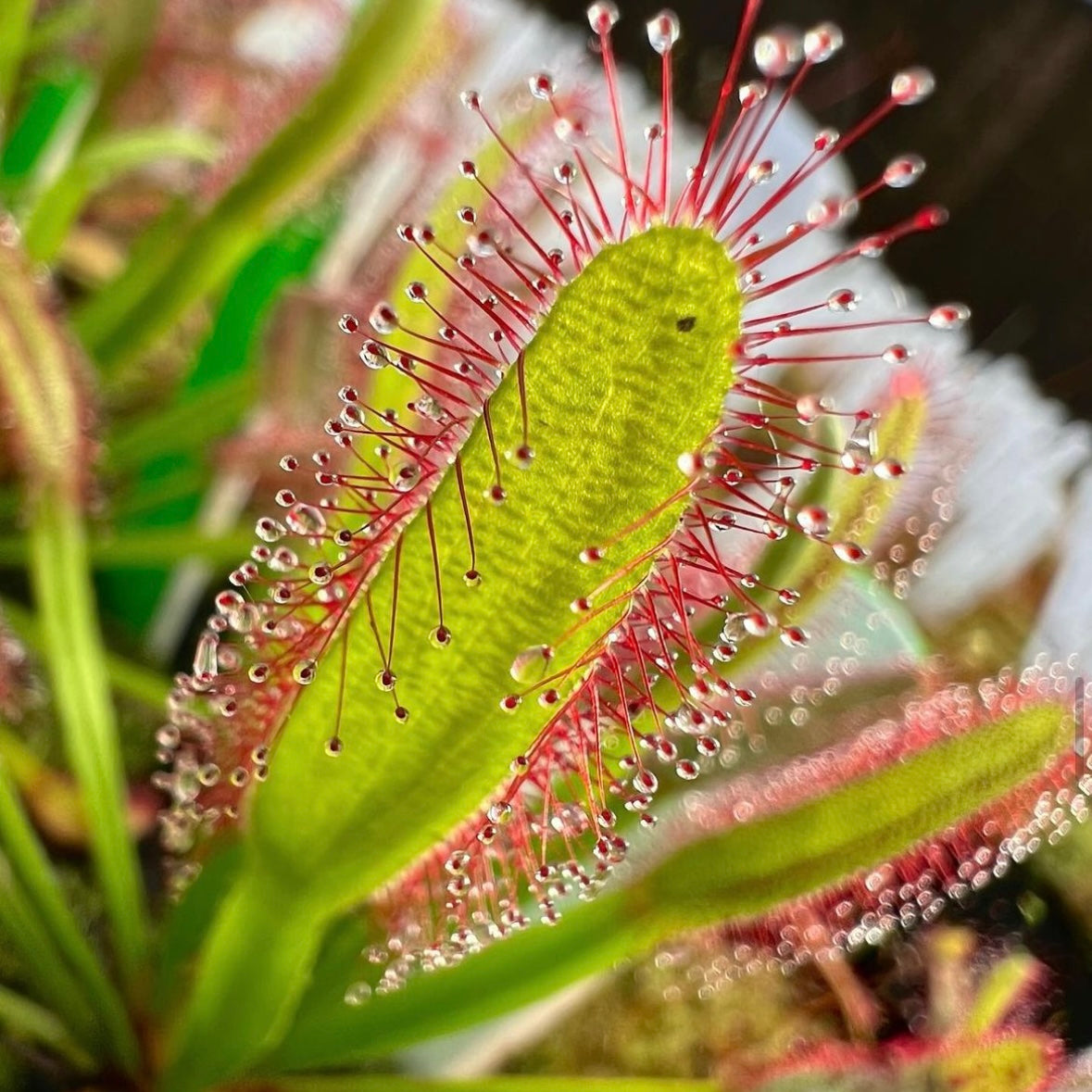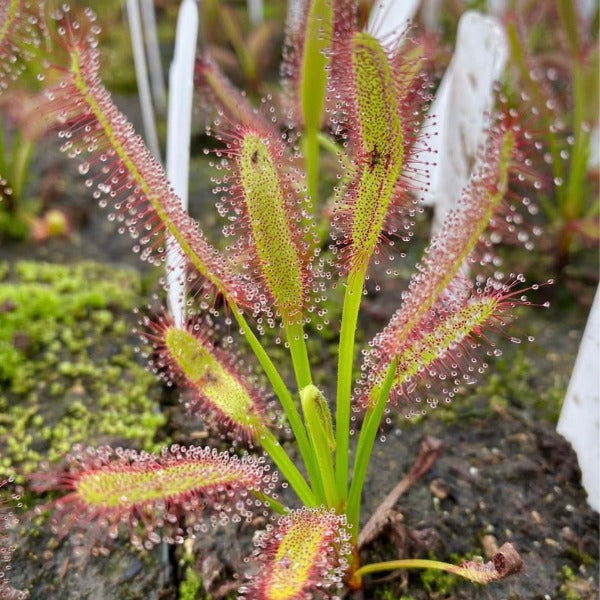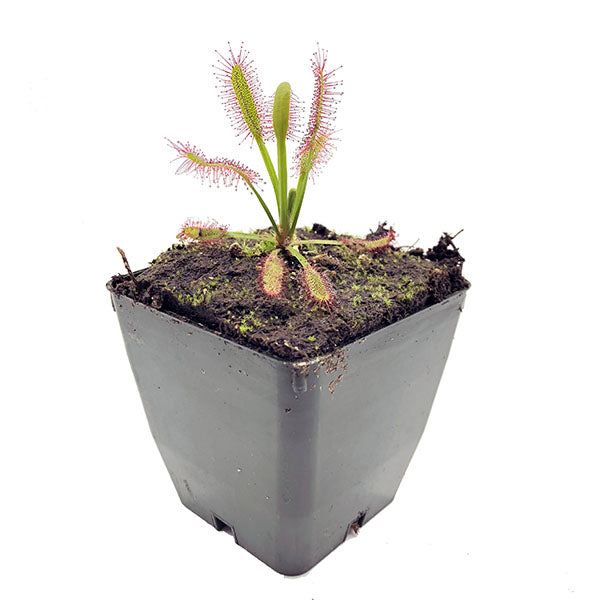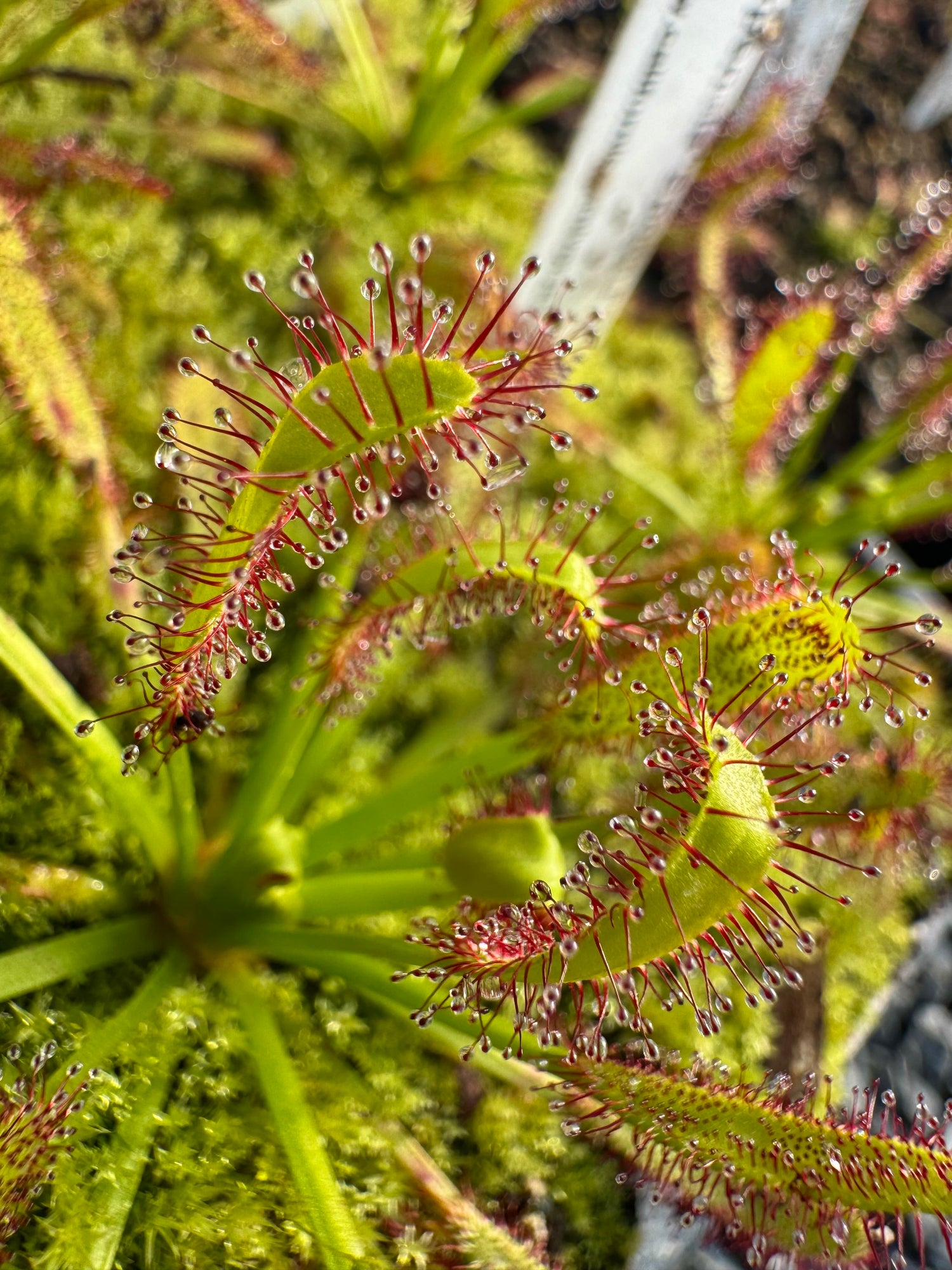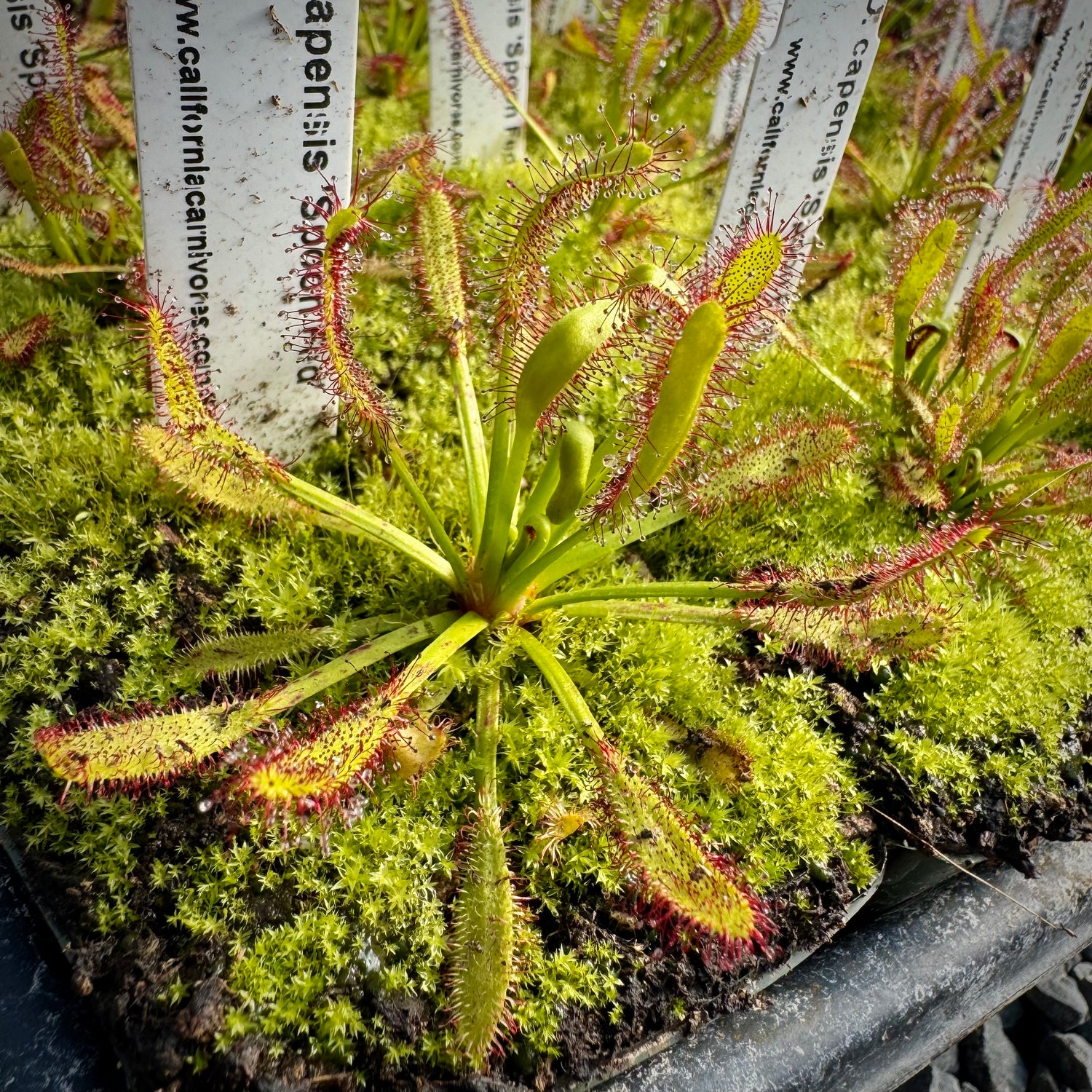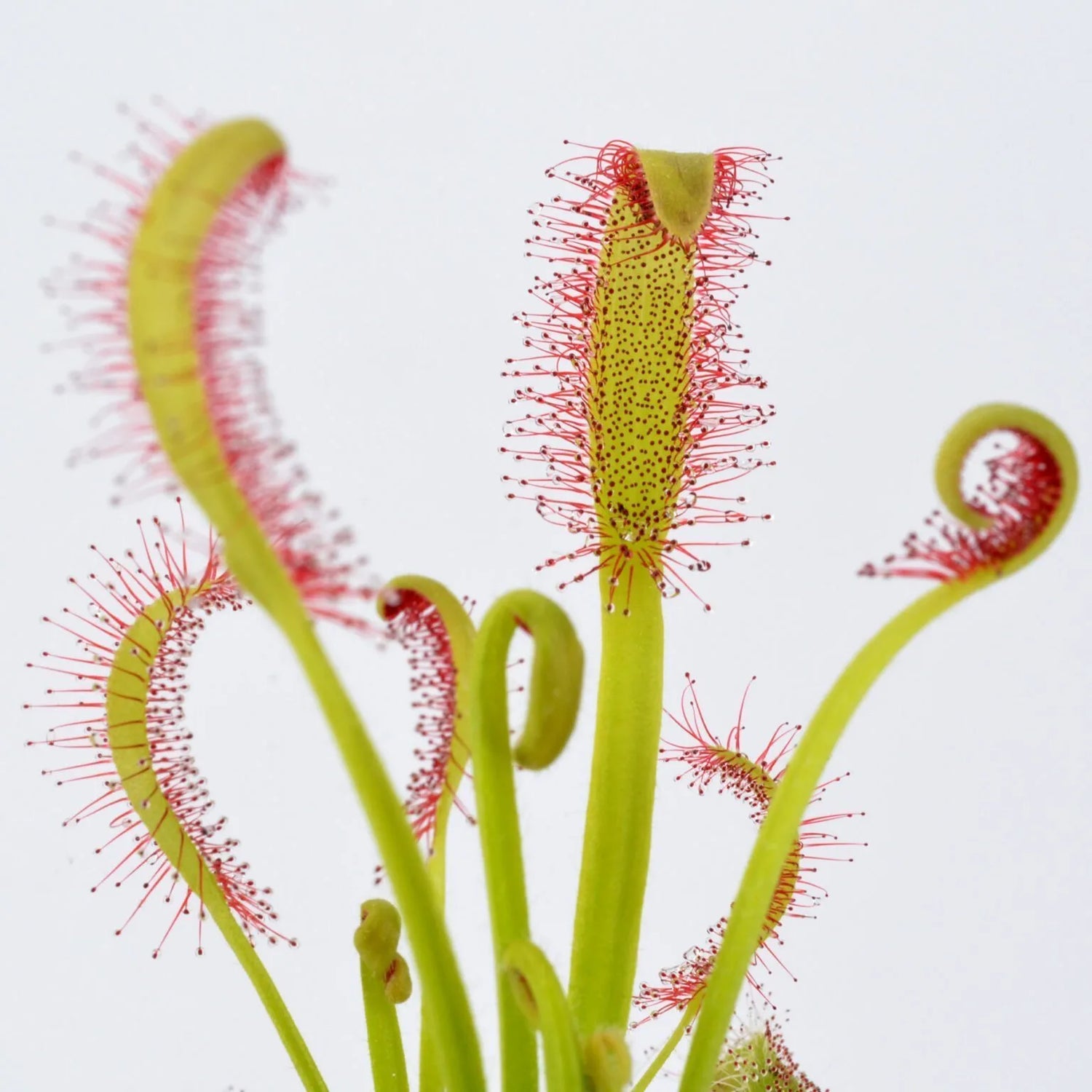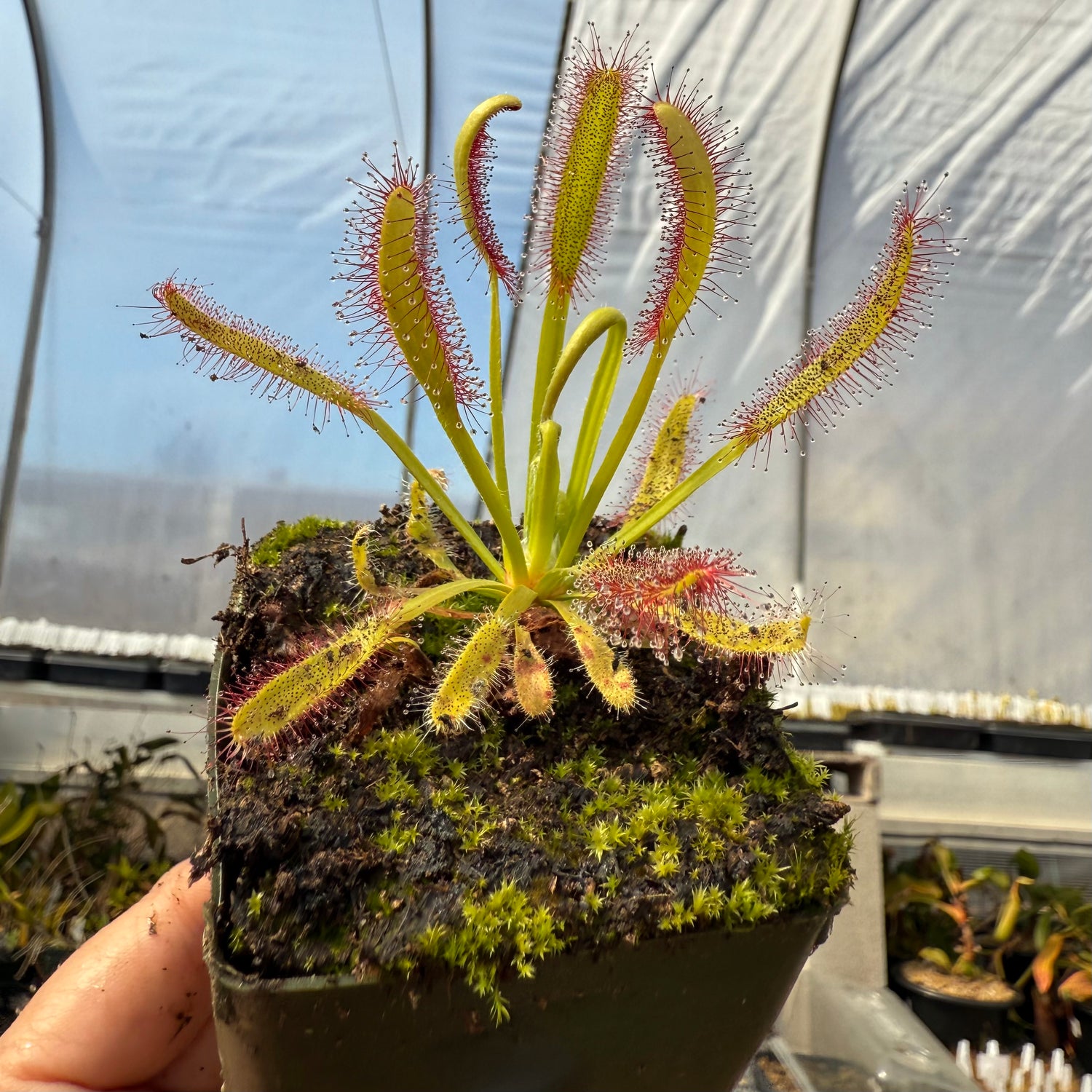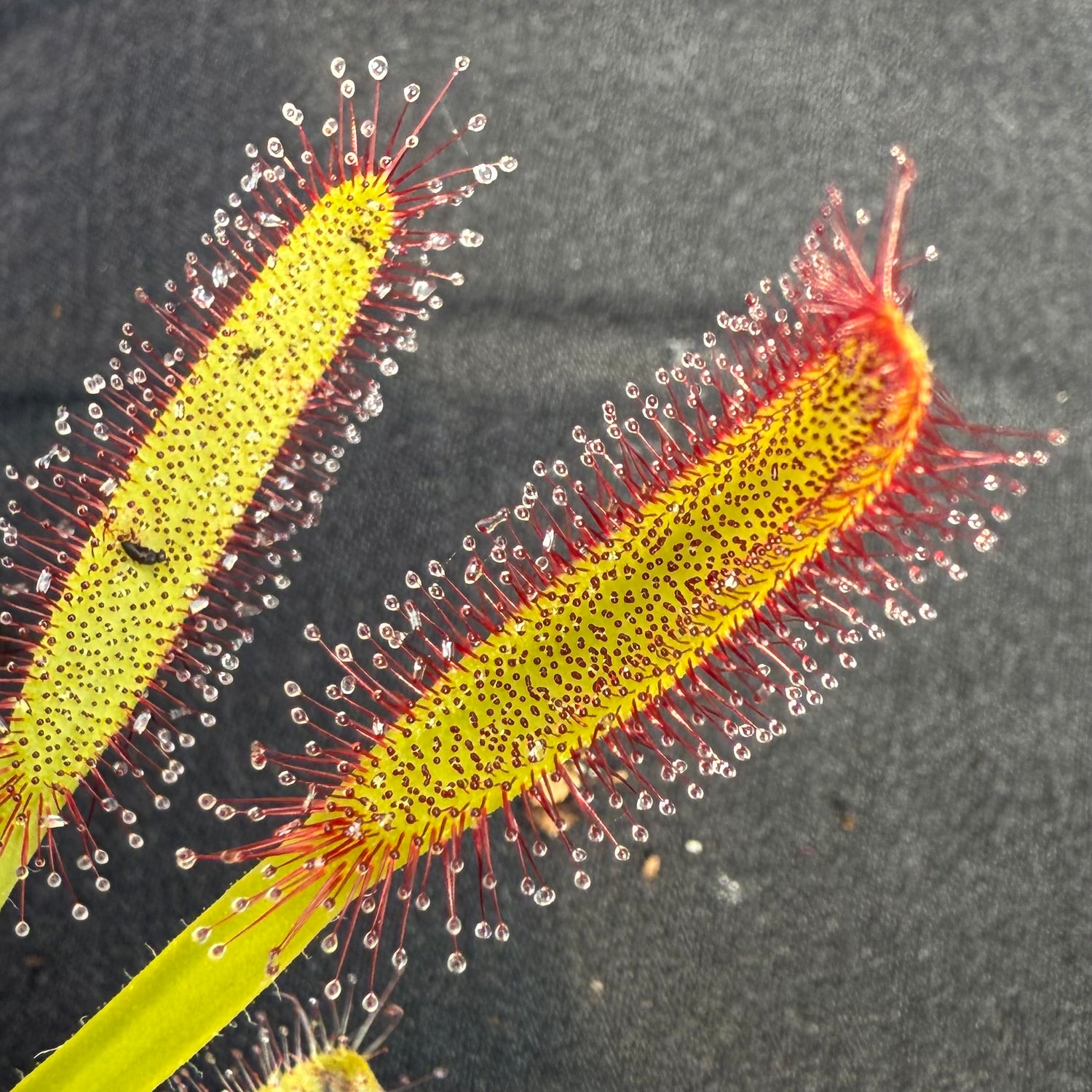Great packaging, fast shipping and item as described. Would buy from CC again.
Sort by:
18 products
18 products
The Alice sundew (Drosera aliciae) is quite possibly the most popular rosetted sundew, and it is easy to see why! It is excellent for terrariums and windowsills, is tolerant of light frost, and is a reliable seed producer. Its handsome wedge-shaped green leaves have bright red tentacles and form rosettes one to three inches across. It often produces offshoots from its roots and slowly produces attractive clumps.
The plants we are shipping have rosettes 1-2” across.
Please note: shipping can be hard on the sticky dew covering the leaves so your plant may arrive without dew. It can take a few weeks for the plant to produce more dew, if after four weeks it has not produced dew, you may need to increase light.
Care Instructions
Growth Habit: This plant grows in a rosette of leaves, slowly growing taller along its stem. As the older leaves die back, they turn brown and form a skirt of older leaves under the new leaves. The stem can be brown as well. Mature rosettes can be 3” across. New leaves grow from the crown of the plant. The roots can be brown to black and thick. The flowers are self-fertile and produce lots of seeds. These plants can regrow from the roots if they die back.
Sun: Full sun indoors, in a terrarium, or outdoors if you live in a nearly frost-free climate. If grown under grow lights, the lights should be on a 10-12 hour day length 6-10” above the plants, depending on the strength of your lights. If your plant does not have dew, it may need more light.
Water & Humidity: Always keep the pot sitting in at least two inches of distilled, rain, or reverse osmosis water. These plants will do best with a humidity of 60% or more.
Temperature & Dormancy: 50 degrees—90 degrees, with high humidity. This species has no winter dormancy but may grow more slowly in winter if exposed to cooler temperatures and shorter photoperiods. This is a tropical plant and can not tolerate cold temperatures. Never expose it to anything below 40 degrees.
Soil & Repotting: We prefer a mix of four-part fertilizer-free peat moss to one-part perlite. You can add our pre-made mix to your order here. You do not need to repot your plant when you receive it from us for at least a year, and we recommend against it during the spring-summer months. Repot Drosera every 1-3 years. Avoid placing in excessively large pots; size up only a few inches at a time, but they appreciate tall pots. Soil can also develop a swampy smell, especially right after shipping, when the plant is wrapped in plastic and sealed. This is normal; these plants grow naturally in bogs and swampy conditions, and peat moss can develop a bit of an anaerobic smell, but this does not indicate a problem with the soil.
Feeding and Fertilizer: Drosera will catch plenty of food when grown outdoors. When grown indoors, they will significantly benefit from a foliar fertilizer. Plants grown outdoors will appreciate a foliar feed as well. Apply MaxSea fertilizer once per month to the foliage only. Dilute 1/4 teaspoon of MaxSea into one gallon of water and then apply to the leaves with a mister bottle or a watering can.
More Information: For further information on dormancy, repotting, dividing, and more, check out our website or our YouTube channel.
These beautiful sundews (Drosera capensis) are the albino form of the Cape Sundew. 'Alba' lacks red pigment (anthocyanin), so its tentacles aren't red, and the flowers are white. Grow it next to the red Cape Sundew or a red Sarracenia for a stunning contrast! Cape Sundews catch gnats, fruit flies, and occasional house flies.
If you have been thinking about growing carnivorous plants but don't know where to start, look no further than Drosera capensis. These plants are easy to grow and rewarding and will grow in various conditions. They will thrive indoors in full sun, on a windowsill, or under lights. They will also do well outside in lots of sun and are cold hardy down to 40 degrees reliably. They will briefly freeze with the leaves dying back, but the plants regrow readily from the roots in spring.
The plants we are shipping are about 2-4” tall.
Please note: shipping can be hard on the sticky dew covering the leaves so your plant may arrive without dew. It can take a few weeks for the plant to produce more dew, if after four weeks it has not produced dew, you may need to increase light.
Care Instructions
Growth Habit: Drosera capensis are small, bushy plants that grow about 6” tall at maturity, although some forms can be slightly larger. Capensis spread readily by dropping seeds from their abundant flowers in their pots, which do not need to be pollinated. As they grow, their leaves die back, starting from the base of the plant and moving up. The leaves die back and can be cut off. The stem will thicken and be black or brown. Sometimes larger, older plants will flop over and grow sideways as they age, growing taller and taller with new leaves emerging from the top of the plant. Capensis can regrow from the roots quite readily, so if your crown dies, keep nurturing it, and you should see new growth. These plants have a high leaf turnover, meaning their leaves die back frequently, but new leaves grow just as fast.
Sun: Full sun. Grow indoors on a sunny windowsill, in a terrarium under lights, or outdoors. If grown indoors, Drosera will require full sun to produce their sticky dew, so be sure to place them in a window where they will receive direct sunlight for most of the day. If grown under lights, keep your grow lights on a 10 to 12-hour day length and hang your grow lights 6 to 10 inches above the plants on the quality of your lights. Grown outdoors, these plants will enjoy a great deal of sun. If you live somewhere extremely hot, for example, Arizona, you will want to protect them from the Full intensity of the afternoon sunlight. You can either grow them in morning sun only, or use shade cloth to help protect them in these very hot areas. These plants may be more colorful and smaller when grown outdoors because the light is more intense. You can expect a few leaves to burn back when you first place your plant outdoors in the sun, and if you receive your plant in the summer, it is a good idea to slowly acclimate it to the sunlight over a day or two. Even in less sunny seasons, areas, or with acclimation, you can still expect to see some burned leaves when first placed outside. This is normal, and new leaves will grow that are more adjusted to the sun. In winter, when grown in sunlight, indoors or outdoors, it is very normal for color to fade from red varieties due to less sun. IF YOUR SUNDEW IS NOT PRODUCING DEW, IT MOST LIKELY NEEDS MORE SUNLIGHT. It can also take a few weeks after shipping for dew to generate.
Water: Always sitting in a few inches of distilled, rain, or reverse osmosis water. These plants always prefer to have their roots wet and can have their pots sitting in a deep saucer of water all the time.
Temperature and Dormancy: Drosera capensis tolerate a wide range of temperatures but will be happiest in 40 - 80 degrees. They can take temperatures from freezing to 100 degrees but only for short periods and can grow back from the roots after a freeze if the daytime temperatures increase above 40. Drosera capensis do not need a dormancy but will die back or slow growth in winter depending on the conditions they are exposed to. If exposed to freezes, they will die back. And many will slow their growth or grow smaller in winter. Drosera capensis does need a nighttime drop in temperatures of 10-20 degrees; if you’d like to grow this in a tropical zone, we recommend the ‘Alba’ cultivar as it can tolerate no nighttime drop in temperature.
Soil and Repotting: We prefer a mix of four-part fertilizer-free peat moss to one-part perlite. You can add our pre-made mix to your order here. You do not need to repot your plant when you receive it from us for at least a year, and we recommend against it during the spring-summer months. Repot Drosera every 1-3 years. Avoid placing in excessively large pots; size up only a few inches at a time. Soil can also develop a swampy smell, especially right after shipping, when the plant is wrapped in plastic and sealed. This is normal; these plants grow naturally in bogs and swampy conditions, and peat moss can develop a bit of an anaerobic smell, but this does not indicate a problem with the soil.
Feeding and Fertilizer: Drosera catch small insects like fungus gnats and fruit flies in their sticky dew. They can catch bigger prey like houseflies or crane flies and can slowly curl their leaves around these larger bugs to make better contact. Over time, their leaves will produce enzymes to digest the nutrients from the bug, absorbing them through their leaves, leaving only the exoskeleton on their sticky leaves. There’s no need to remove these as they often serve as a lure to other insects looking for an easy meal. When grown outdoors, they will catch plenty of food. When grown indoors, they will significantly benefit from a foliar fertilizer. Plants grown outdoors will appreciate a foliar feed as well. Apply MaxSea fertilizer once per month to the foliage only. Dilute 1/4 teaspoon of MaxSea into one gallon of water with a mister bottle or a watering can. Watch as the Drosera slowly curl their leaves after a foliar fertilizer application!
More Information: For further information on dormancy, repotting, growing from seed, and more, check out our website or our YouTube channel.
If you have been thinking about growing carnivorous plants but don't know where to start, look no further than Drosera capensis. These plants are easy to grow, rewarding and will grow in a variety of conditions. They will thrive indoors in full sun, on a windowsill or under lights. They will also do well outside in lots of sun and are cold hardy down to 40 degrees reliably. They will even take a brief freeze with the leaves dying back but the plants regrowing readily from the roots in spring.
This is the most typical form of Drosera capensis; the leaves are thin and delicate looking with red tentacles tipped in mucilage. The pink flowers unfurl off of long, arching scapes. Cape Sundews catch many gnats, fruit flies and occasionally house flies.
The plants we are shipping are about 2-4” tall.
Please note: shipping can be hard on the sticky dew covering the leaves so your plant may arrive without dew. It can take a few weeks for the plant to produce more dew, if after four weeks it has not produced dew, you may need to increase light.
Care Instructions
Growth Habit: Drosera capensis are small, bushy plants that grow about 6” tall at maturity, although some forms can be slightly larger. Capensis spread readily by dropping seeds from their abundant flowers in their pots, which do not need to be pollinated. As they grow, their leaves die back, starting from the base of the plant and moving up. The leaves die back and can be cut off. The stem will thicken and be black or brown. Sometimes larger, older plants will flop over and grow sideways as they age, growing taller and taller with new leaves emerging from the top of the plant. Capensis can regrow from the roots quite readily, so if your crown dies, keep nurturing it, and you should see new growth. These plants have a high leaf turnover, meaning their leaves die back frequently, but new leaves grow just as fast.
Sun: Full sun. Grow indoors on a sunny windowsill, in a terrarium under lights, or outdoors. If grown indoors, Drosera will require full sun to produce their sticky dew, so be sure to place them in a window where they will receive direct sunlight for most of the day. If grown under lights, keep your grow lights on a 10 to 12-hour day length and hang your grow lights 6 to 10 inches above the plants on the quality of your lights. Grown outdoors, these plants will enjoy a great deal of sun. If you live somewhere extremely hot, for example, Arizona, you will want to protect them from the Full intensity of the afternoon sunlight. You can either grow them in morning sun only, or use shade cloth to help protect them in these very hot areas. These plants may be more colorful and smaller when grown outdoors because the light is more intense. You can expect a few leaves to burn back when you first place your plant outdoors in the sun, and if you receive your plant in the summer, it is a good idea to slowly acclimate it to the sunlight over a day or two. Even in less sunny seasons, areas, or with acclimation, you can still expect to see some burned leaves when first placed outside. This is normal, and new leaves will grow that are more adjusted to the sun. In winter, when grown in sunlight, indoors or outdoors, it is very normal for color to fade from red varieties due to less sun. IF YOUR SUNDEW IS NOT PRODUCING DEW, IT MOST LIKELY NEEDS MORE SUNLIGHT. It can also take a few weeks after shipping for dew to generate.
Water: Always sitting in a few inches of distilled, rain, or reverse osmosis water. These plants always prefer to have their roots wet and can have their pots sitting in a deep saucer of water all the time.
Temperature and Dormancy: Drosera capensis tolerate a wide range of temperatures but will be happiest in 40 - 80 degrees. They can take temperatures from freezing to 100 degrees but only for short periods and can grow back from the roots after a freeze if the daytime temperatures increase above 40. Drosera capensis do not need a dormancy but will die back or slow growth in winter depending on the conditions they are exposed to. If exposed to freezes, they will die back. And many will slow their growth or grow smaller in winter. Drosera capensis does need a nighttime drop in temperatures of 10-20 degrees; if you’d like to grow this in a tropical zone, we recommend the ‘Alba’ cultivar as it can tolerate no nighttime drop in temperature.
Soil and Repotting: We prefer a mix of four-part fertilizer-free peat moss to one-part perlite. You can add our pre-made mix to your order here. You do not need to repot your plant when you receive it from us for at least a year, and we recommend against it during the spring-summer months. Repot Drosera every 1-3 years. Avoid placing in excessively large pots; size up only a few inches at a time. Soil can also develop a swampy smell, especially right after shipping, when the plant is wrapped in plastic and sealed. This is normal; these plants grow naturally in bogs and swampy conditions, and peat moss can develop a bit of an anaerobic smell, but this does not indicate a problem with the soil.
Feeding and Fertilizer: Drosera catch small insects like fungus gnats and fruit flies in their sticky dew. They can catch bigger prey like houseflies or crane flies and can slowly curl their leaves around these larger bugs to make better contact. Over time, their leaves will produce enzymes to digest the nutrients from the bug, absorbing them through their leaves, leaving only the exoskeleton on their sticky leaves. There’s no need to remove these as they often serve as a lure to other insects looking for an easy meal. When grown outdoors, they will catch plenty of food. When grown indoors, they will significantly benefit from a foliar fertilizer. Plants grown outdoors will appreciate a foliar feed as well. Apply MaxSea fertilizer once per month to the foliage only. Dilute 1/4 teaspoon of MaxSea into one gallon of water with a mister bottle or a watering can. Watch as the Drosera slowly curl their leaves after a foliar fertilizer application!
More Information: For further information on dormancy, repotting, growing from seed, and more, check out our website or our YouTube channel.
This is probably Damon's favorite cape sundew! Peter sold him one at a flea market when Damon was a little boy and it is the plant that got himinto carnivorous plants! We're still selling this easy to grow beauty; it has very wide leaves which make it look a bit more robust than the other clones we sell. A perfect first plant for anyone!
If you have been thinking about growing carnivorous plants but don't know where to start, look no further than Drosera capensis. These plants are easy to grow, rewarding and will grow in a variety of conditions. They will thrive indoors in full sun, on a windowsill or under lights. They will also do well outside in lots of sun and are cold hardy down to 40 degrees reliably. They will even take a brief freeze with the leaves dying back but the plants regrowing readily from the roots in spring.
The plants we are shipping are 2-4” tall.
Please note: shipping can be hard on the sticky dew covering the leaves so your plant may arrive without dew. It can take a few weeks for the plant to produce more dew, if after four weeks it has not produced dew, you may need to increase light.
Care Instructions
Growth Habit: Drosera capensis are small, bushy plants that grow about 6” tall at maturity, although some forms can be slightly larger. Capensis spread readily by dropping seeds from their abundant flowers in their pots, which do not need to be pollinated. As they grow, their leaves die back, starting from the base of the plant and moving up. The leaves die back and can be cut off. The stem will thicken and be black or brown. Sometimes larger, older plants will flop over and grow sideways as they age, growing taller and taller with new leaves emerging from the top of the plant. Capensis can regrow from the roots quite readily, so if your crown dies, keep nurturing it, and you should see new growth. These plants have a high leaf turnover, meaning their leaves die back frequently, but new leaves grow just as fast.
Sun: Full sun. Grow indoors on a sunny windowsill, in a terrarium under lights, or outdoors. If grown indoors, Drosera will require full sun to produce their sticky dew, so be sure to place them in a window where they will receive direct sunlight for most of the day. If grown under lights, keep your grow lights on a 10 to 12-hour day length and hang your grow lights 6 to 10 inches above the plants on the quality of your lights. Grown outdoors, these plants will enjoy a great deal of sun. If you live somewhere extremely hot, for example, Arizona, you will want to protect them from the Full intensity of the afternoon sunlight. You can either grow them in morning sun only, or use shade cloth to help protect them in these very hot areas. These plants may be more colorful and smaller when grown outdoors because the light is more intense. You can expect a few leaves to burn back when you first place your plant outdoors in the sun, and if you receive your plant in the summer, it is a good idea to slowly acclimate it to the sunlight over a day or two. Even in less sunny seasons, areas, or with acclimation, you can still expect to see some burned leaves when first placed outside. This is normal, and new leaves will grow that are more adjusted to the sun. In winter, when grown in sunlight, indoors or outdoors, it is very normal for color to fade from red varieties due to less sun. IF YOUR SUNDEW IS NOT PRODUCING DEW, IT MOST LIKELY NEEDS MORE SUNLIGHT. It can also take a few weeks after shipping for dew to generate.
Water: Always sitting in a few inches of distilled, rain, or reverse osmosis water. These plants always prefer to have their roots wet and can have their pots sitting in a deep saucer of water all the time.
Temperature and Dormancy: Drosera capensis tolerate a wide range of temperatures but will be happiest in 40 - 80 degrees. They can take temperatures from freezing to 100 degrees but only for short periods and can grow back from the roots after a freeze if the daytime temperatures increase above 40. Drosera capensis do not need a dormancy but will die back or slow growth in winter depending on the conditions they are exposed to. If exposed to freezes, they will die back. And many will slow their growth or grow smaller in winter. Drosera capensis does need a nighttime drop in temperatures of 10-20 degrees; if you’d like to grow this in a tropical zone, we recommend the ‘Alba’ cultivar as it can tolerate no nighttime drop in temperature.
Soil and Repotting: We prefer a mix of four-part fertilizer-free peat moss to one-part perlite. You can add our pre-made mix to your order here. You do not need to repot your plant when you receive it from us for at least a year, and we recommend against it during the spring-summer months. Repot Drosera every 1-3 years. Avoid placing in excessively large pots; size up only a few inches at a time. Soil can also develop a swampy smell, especially right after shipping, when the plant is wrapped in plastic and sealed. This is normal; these plants grow naturally in bogs and swampy conditions, and peat moss can develop a bit of an anaerobic smell, but this does not indicate a problem with the soil.
Feeding and Fertilizer: Drosera catch small insects like fungus gnats and fruit flies in their sticky dew. They can catch bigger prey like houseflies or crane flies and can slowly curl their leaves around these larger bugs to make better contact. Over time, their leaves will produce enzymes to digest the nutrients from the bug, absorbing them through their leaves, leaving only the exoskeleton on their sticky leaves. There’s no need to remove these as they often serve as a lure to other insects looking for an easy meal. When grown outdoors, they will catch plenty of food. When grown indoors, they will significantly benefit from a foliar fertilizer. Plants grown outdoors will appreciate a foliar feed as well. Apply MaxSea fertilizer once per month to the foliage only. Dilute 1/4 teaspoon of MaxSea into one gallon of water with a mister bottle or a watering can. Watch as the Drosera slowly curl their leaves after a foliar fertilizer application!
More Information: For further information on dormancy, repotting, growing from seed, and more, check out our website or our YouTube channel.
Drosera capensis ‘Big Pink’ is a gorgeous capensis known for both its large size abs its lovely pink coloration! Plants can easily grow to 6” across and when grown in strong light, they turn a pleasant shade of pink!
The plants we are shipping are 2-4” tall. The third photo shows the size of the plants we are shipping and the last photo shows how big they can get!
Please note: shipping can be hard on the sticky dew covering the leaves so your plant may arrive without dew. It can take a few weeks for the plant to produce more dew, if after four weeks it has not produced dew, you may need to increase light.
Care Instructions
Growth Habit: Drosera capensis are small, bushy plants that grow about 6” tall at maturity, although some forms can be slightly larger. Capensis spread readily by dropping seeds from their abundant flowers in their pots, which do not need to be pollinated. As they grow, their leaves die back, starting from the base of the plant and moving up. The leaves die back and can be cut off. The stem will thicken and be black or brown. Sometimes larger, older plants will flop over and grow sideways as they age, growing taller and taller with new leaves emerging from the top of the plant. Capensis can regrow from the roots quite readily, so if your crown dies, keep nurturing it, and you should see new growth. These plants have a high leaf turnover, meaning their leaves die back frequently, but new leaves grow just as fast.
Sun: Full sun. Grow indoors on a sunny windowsill, in a terrarium under lights, or outdoors. If grown indoors, Drosera will require full sun to produce their sticky dew, so be sure to place them in a window where they will receive direct sunlight for most of the day. If grown under lights, keep your grow lights on a 10 to 12-hour day length and hang your grow lights 6 to 10 inches above the plants on the quality of your lights. Grown outdoors, these plants will enjoy a great deal of sun. If you live somewhere extremely hot, for example, Arizona, you will want to protect them from the Full intensity of the afternoon sunlight. You can either grow them in morning sun only, or use shade cloth to help protect them in these very hot areas. These plants may be more colorful and smaller when grown outdoors because the light is more intense. You can expect a few leaves to burn back when you first place your plant outdoors in the sun, and if you receive your plant in the summer, it is a good idea to slowly acclimate it to the sunlight over a day or two. Even in less sunny seasons, areas, or with acclimation, you can still expect to see some burned leaves when first placed outside. This is normal, and new leaves will grow that are more adjusted to the sun. In winter, when grown in sunlight, indoors or outdoors, it is very normal for color to fade from red varieties due to less sun. IF YOUR SUNDEW IS NOT PRODUCING DEW, IT MOST LIKELY NEEDS MORE SUNLIGHT. It can also take a few weeks after shipping for dew to generate.
Water: Always sitting in a few inches of distilled, rain, or reverse osmosis water. These plants always prefer to have their roots wet and can have their pots sitting in a deep saucer of water all the time.
Temperature and Dormancy: Drosera capensis tolerate a wide range of temperatures but will be happiest in 40 - 80 degrees. They can take temperatures from freezing to 100 degrees but only for short periods and can grow back from the roots after a freeze if the daytime temperatures increase above 40. Drosera capensis do not need a dormancy but will die back or slow growth in winter depending on the conditions they are exposed to. If exposed to freezes, they will die back. And many will slow their growth or grow smaller in winter. Drosera capensis does need a nighttime drop in temperatures of 10-20 degrees; if you’d like to grow this in a tropical zone, we recommend the ‘Alba’ cultivar as it can tolerate no nighttime drop in temperature.
Soil and Repotting: We prefer a mix of four-part fertilizer-free peat moss to one-part perlite. You can add our pre-made mix to your order here. You do not need to repot your plant when you receive it from us for at least a year, and we recommend against it during the spring-summer months. Repot Drosera every 1-3 years. Avoid placing in excessively large pots; size up only a few inches at a time. Soil can also develop a swampy smell, especially right after shipping, when the plant is wrapped in plastic and sealed. This is normal; these plants grow naturally in bogs and swampy conditions, and peat moss can develop a bit of an anaerobic smell, but this does not indicate a problem with the soil.
Feeding and Fertilizer: Drosera catch small insects like fungus gnats and fruit flies in their sticky dew. They can catch bigger prey like houseflies or crane flies and can slowly curl their leaves around these larger bugs to make better contact. Over time, their leaves will produce enzymes to digest the nutrients from the bug, absorbing them through their leaves, leaving only the exoskeleton on their sticky leaves. There’s no need to remove these as they often serve as a lure to other insects looking for an easy meal. When grown outdoors, they will catch plenty of food. When grown indoors, they will significantly benefit from a foliar fertilizer. Plants grown outdoors will appreciate a foliar feed as well. Apply MaxSea fertilizer once per month to the foliage only. Dilute 1/4 teaspoon of MaxSea into one gallon of water with a mister bottle or a watering can. Watch as the Drosera slowly curl their leaves after a foliar fertilizer application!
More Information: For further information on dormancy, repotting, growing from seed, and more, check out our website or our YouTube channel.
We love all the different forms of Drosera capensis! These plants are beautiful, fun to grow, and very rewarding! If you want to grow a carnivorous plant, a Cape Sundew is the perfect one to start with!
This is a new cultivar to us, called “Dark Maroon.” It is an all-red form, with both the tentacles and the petioles flushing a deep red!
The plants we are shipping are about 2-3” tall.
Please note: Shipping can be hard on the sticky dew covering the leaves, so your plant may arrive without dew. It can take a few weeks for the plant to produce more dew. If after four weeks it has not produced dew, you may need to increase light.
Care Instructions
Growth Habit: Drosera capensis are small, bushy plants that grow about 6” tall at maturity, although some forms can be slightly larger. Capensis spread readily by dropping seeds from their abundant flowers in their pots, which do not need to be pollinated. As they grow, their leaves die back, starting from the base of the plant and moving up. The leaves die back and can be cut off. The stem will thicken and be black or brown. Sometimes larger, older plants will flop over and grow sideways as they age, growing taller and taller with new leaves emerging from the top of the plant. Capensis can regrow from the roots quite readily, so if your crown dies, keep nurturing it, and you should see new growth. These plants have a high leaf turnover, meaning their leaves die back frequently, but new leaves grow just as fast.
Sun: Full sun. Grow indoors on a sunny windowsill, in a terrarium under lights, or outdoors. If grown indoors, Drosera will require full sun to produce their sticky dew, so be sure to place them in a window where they will receive direct sunlight for most of the day. If grown under lights, keep your grow lights on a 10 to 12-hour day length and hang your grow lights 6 to 10 inches above the plants on the quality of your lights. Grown outdoors, these plants will enjoy a great deal of sun. If you live somewhere extremely hot, for example, Arizona, you will want to protect them from the Full intensity of the afternoon sunlight. You can either grow them in morning sun only, or use shade cloth to help protect them in these very hot areas. These plants may be more colorful and smaller when grown outdoors because the light is more intense. You can expect a few leaves to burn back when you first place your plant outdoors in the sun, and if you receive your plant in the summer, it is a good idea to slowly acclimate it to the sunlight over a day or two. Even in less sunny seasons, areas, or with acclimation, you can still expect to see some burned leaves when first placed outside. This is normal, and new leaves will grow that are more adjusted to the sun. In winter, when grown in sunlight, indoors or outdoors, it is very normal for color to fade from red varieties due to less sun. IF YOUR SUNDEW IS NOT PRODUCING DEW, IT MOST LIKELY NEEDS MORE SUNLIGHT. It can also take a few weeks after shipping for dew to generate.
Water: Always sitting in a few inches of distilled, rain, or reverse osmosis water. These plants always prefer to have their roots wet and can have their pots sitting in a deep saucer of water all the time.
Temperature and Dormancy: Drosera capensis tolerate a wide range of temperatures but will be happiest in 40 - 80 degrees. They can take temperatures from freezing to 100 degrees but only for short periods and can grow back from the roots after a freeze if the daytime temperatures increase above 40. Drosera capensis do not need a dormancy but will die back or slow growth in winter depending on the conditions they are exposed to. If exposed to freezes, they will die back. And many will slow their growth or grow smaller in winter. Drosera capensis does need a nighttime drop in temperatures of 10-20 degrees; if you’d like to grow this in a tropical zone, we recommend the ‘Alba’ cultivar as it can tolerate no nighttime drop in temperature.
Soil and Repotting: We prefer a mix of four-part fertilizer-free peat moss to one-part perlite. You can add our pre-made mix to your order here. You do not need to repot your plant when you receive it from us for at least a year, and we recommend against it during the spring-summer months. Repot Drosera every 1-3 years. Avoid placing in excessively large pots; size up only a few inches at a time. Soil can also develop a swampy smell, especially right after shipping, when the plant is wrapped in plastic and sealed. This is normal; these plants grow naturally in bogs and swampy conditions, and peat moss can develop a bit of an anaerobic smell, but this does not indicate a problem with the soil.
Feeding and Fertilizer: Drosera catch small insects like fungus gnats and fruit flies in their sticky dew. They can catch bigger prey like houseflies or crane flies and can slowly curl their leaves around these larger bugs to make better contact. Over time, their leaves will produce enzymes to digest the nutrients from the bug, absorbing them through their leaves, leaving only the exoskeleton on their sticky leaves. There’s no need to remove these as they often serve as a lure to other insects looking for an easy meal. When grown outdoors, they will catch plenty of food. When grown indoors, they will significantly benefit from a foliar fertilizer. Plants grown outdoors will appreciate a foliar feed as well. Apply MaxSea fertilizer once per month to the foliage only. Dilute 1/4 teaspoon of MaxSea into one gallon of water with a mister bottle or a watering can. Watch as the Drosera slowly curl their leaves after a foliar fertilizer application!
More Information: For further information on dormancy, repotting, growing from seed, and more, check out our website or our YouTube channel.
Cape sundews are some of the easiest and most forgiving carnivorous plants to grow! There’s something magical about these dew-covered plants! Each leaf is covered in tons of dewy tentacles, waiting to lure in, trap, and eat insects like fungus gnats and fruit flies.
This is a new cultivar to us, called “Mini Red.” It has a slightly smaller stature than other capensis—a charmingly petite plant! It is covered in red tentacles with green petioles.
The plants we are shipping are about 2-3” tall.
Please note: Shipping can be hard on the sticky dew covering the leaves, so your plant may arrive without dew. It can take a few weeks for the plant to produce more dew. If after four weeks it has not produced dew, you may need to increase light.
Care Instructions
Growth Habit: Drosera capensis are small, bushy plants that grow about 6” tall at maturity, although some forms can be slightly larger and this form is likely much smaller. Capensis spread readily by dropping seeds from their abundant flowers in their pots, which do not need to be pollinated. As they grow, their leaves die back, starting from the base of the plant and moving up. The leaves die back and can be cut off. The stem will thicken and be black or brown. Sometimes larger, older plants will flop over and grow sideways as they age, growing taller and taller with new leaves emerging from the top of the plant. Capensis can regrow from the roots quite readily, so if your crown dies, keep nurturing it, and you should see new growth. These plants have a high leaf turnover, meaning their leaves die back frequently, but new leaves grow just as fast.
Sun: Full sun. Grow indoors on a sunny windowsill, in a terrarium under lights, or outdoors. If grown indoors, Drosera will require full sun to produce their sticky dew, so be sure to place them in a window where they will receive direct sunlight for most of the day. If grown under lights, keep your grow lights on a 10 to 12-hour day length and hang your grow lights 6 to 10 inches above the plants on the quality of your lights. Grown outdoors, these plants will enjoy a great deal of sun. If you live somewhere extremely hot, for example, Arizona, you will want to protect them from the Full intensity of the afternoon sunlight. You can either grow them in morning sun only, or use shade cloth to help protect them in these very hot areas. These plants may be more colorful and smaller when grown outdoors because the light is more intense. You can expect a few leaves to burn back when you first place your plant outdoors in the sun, and if you receive your plant in the summer, it is a good idea to slowly acclimate it to the sunlight over a day or two. Even in less sunny seasons, areas, or with acclimation, you can still expect to see some burned leaves when first placed outside. This is normal, and new leaves will grow that are more adjusted to the sun. In winter, when grown in sunlight, indoors or outdoors, it is very normal for color to fade from red varieties due to less sun. IF YOUR SUNDEW IS NOT PRODUCING DEW, IT MOST LIKELY NEEDS MORE SUNLIGHT. It can also take a few weeks after shipping for dew to generate.
Water: Always sitting in a few inches of distilled, rain, or reverse osmosis water. These plants always prefer to have their roots wet and can have their pots sitting in a deep saucer of water all the time.
Temperature and Dormancy: Drosera capensis tolerate a wide range of temperatures but will be happiest in 40 - 80 degrees. They can take temperatures from freezing to 100 degrees but only for short periods and can grow back from the roots after a freeze if the daytime temperatures increase above 40. Drosera capensis do not need a dormancy but will die back or slow growth in winter depending on the conditions they are exposed to. If exposed to freezes, they will die back. And many will slow their growth or grow smaller in winter. Drosera capensis does need a nighttime drop in temperatures of 10-20 degrees; if you’d like to grow this in a tropical zone, we recommend the ‘Alba’ cultivar as it can tolerate no nighttime drop in temperature.
Soil and Repotting: We prefer a mix of four-part fertilizer-free peat moss to one-part perlite. You can add our pre-made mix to your order here. You do not need to repot your plant when you receive it from us for at least a year, and we recommend against it during the spring-summer months. Repot Drosera every 1-3 years. Avoid placing in excessively large pots; size up only a few inches at a time. Soil can also develop a swampy smell, especially right after shipping, when the plant is wrapped in plastic and sealed. This is normal; these plants grow naturally in bogs and swampy conditions, and peat moss can develop a bit of an anaerobic smell, but this does not indicate a problem with the soil.
Feeding and Fertilizer: Drosera catch small insects like fungus gnats and fruit flies in their sticky dew. They can catch bigger prey like houseflies or crane flies and can slowly curl their leaves around these larger bugs to make better contact. Over time, their leaves will produce enzymes to digest the nutrients from the bug, absorbing them through their leaves, leaving only the exoskeleton on their sticky leaves. There’s no need to remove these as they often serve as a lure to other insects looking for an easy meal. When grown outdoors, they will catch plenty of food. When grown indoors, they will significantly benefit from a foliar fertilizer. Plants grown outdoors will appreciate a foliar feed as well. Apply MaxSea fertilizer once per month to the foliage only. Dilute 1/4 teaspoon of MaxSea into one gallon of water with a mister bottle or a watering can. Watch as the Drosera slowly curl their leaves after a foliar fertilizer application!
More Information: For further information on dormancy, repotting, growing from seed, and more, check out our website or our YouTube channel.
The most beautiful and striking of the Cape Sundews, the entire plant will be bright red when grown in full sun. They are slightly slower growing than other Cape Sundews. The flowers are darker pink and on shorter scapes. This form is really exciting because not only is it a bright red color but it is a site location plant from De Kom, RSA.
If you have been thinking about growing carnivorous plants but don't know where to start, look no further than Drosera capensis. These plants are easy to grow, rewarding and will grow in a variety of conditions. They will thrive indoors in full sun, on a windowsill or under lights. They will also do well outside in lots of sun and are cold hardy down to 40 degrees reliably. They will even take a brief freeze with the leaves dying back but the plants regrowing readily from the roots in spring.
Please note; in winter these plants can lose their red pigment and look quite green. They will regain their red coloration again in spring and summer or if grown under lights and exposed to longer photo periods.
The plants we are shipping are about 2-4” tall.
Please note: shipping can be hard on the sticky dew covering the leaves so your plant may arrive without dew. It can take a few weeks for the plant to produce more dew, if after four weeks it has not produced dew, you may need to increase light.
Care Instructions
Growth Habit: Drosera capensis are small, bushy plants that grow about 6” tall at maturity, although some forms can be slightly larger. Capensis spread readily by dropping seeds from their abundant flowers in their pots, which do not need to be pollinated. As they grow, their leaves die back, starting from the base of the plant and moving up. The leaves die back and can be cut off. The stem will thicken and be black or brown. Sometimes larger, older plants will flop over and grow sideways as they age, growing taller and taller with new leaves emerging from the top of the plant. Capensis can regrow from the roots quite readily, so if your crown dies, keep nurturing it, and you should see new growth. These plants have a high leaf turnover, meaning their leaves die back frequently, but new leaves grow just as fast.
Sun: Full sun. Grow indoors on a sunny windowsill, in a terrarium under lights, or outdoors. If grown indoors, Drosera will require full sun to produce their sticky dew, so be sure to place them in a window where they will receive direct sunlight for most of the day. If grown under lights, keep your grow lights on a 10 to 12-hour day length and hang your grow lights 6 to 10 inches above the plants on the quality of your lights. Grown outdoors, these plants will enjoy a great deal of sun. If you live somewhere extremely hot, for example, Arizona, you will want to protect them from the Full intensity of the afternoon sunlight. You can either grow them in morning sun only, or use shade cloth to help protect them in these very hot areas. These plants may be more colorful and smaller when grown outdoors because the light is more intense. You can expect a few leaves to burn back when you first place your plant outdoors in the sun, and if you receive your plant in the summer, it is a good idea to slowly acclimate it to the sunlight over a day or two. Even in less sunny seasons, areas, or with acclimation, you can still expect to see some burned leaves when first placed outside. This is normal, and new leaves will grow that are more adjusted to the sun. In winter, when grown in sunlight, indoors or outdoors, it is very normal for color to fade from red varieties due to less sun. IF YOUR SUNDEW IS NOT PRODUCING DEW, IT MOST LIKELY NEEDS MORE SUNLIGHT. It can also take a few weeks after shipping for dew to generate.
Water: Always sitting in a few inches of distilled, rain, or reverse osmosis water. These plants always prefer to have their roots wet and can have their pots sitting in a deep saucer of water all the time.
Temperature and Dormancy: Drosera capensis tolerate a wide range of temperatures but will be happiest in 40 - 80 degrees. They can take temperatures from freezing to 100 degrees but only for short periods and can grow back from the roots after a freeze if the daytime temperatures increase above 40. Drosera capensis do not need a dormancy but will die back or slow growth in winter depending on the conditions they are exposed to. If exposed to freezes, they will die back. And many will slow their growth or grow smaller in winter. Drosera capensis does need a nighttime drop in temperatures of 10-20 degrees; if you’d like to grow this in a tropical zone, we recommend the ‘Alba’ cultivar as it can tolerate no nighttime drop in temperature.
Soil and Repotting: We prefer a mix of four-part fertilizer-free peat moss to one-part perlite. You can add our pre-made mix to your order here. You do not need to repot your plant when you receive it from us for at least a year, and we recommend against it during the spring-summer months. Repot Drosera every 1-3 years. Avoid placing in excessively large pots; size up only a few inches at a time. Soil can also develop a swampy smell, especially right after shipping, when the plant is wrapped in plastic and sealed. This is normal; these plants grow naturally in bogs and swampy conditions, and peat moss can develop a bit of an anaerobic smell, but this does not indicate a problem with the soil.
Feeding and Fertilizer: Drosera catch small insects like fungus gnats and fruit flies in their sticky dew. They can catch bigger prey like houseflies or crane flies and can slowly curl their leaves around these larger bugs to make better contact. Over time, their leaves will produce enzymes to digest the nutrients from the bug, absorbing them through their leaves, leaving only the exoskeleton on their sticky leaves. There’s no need to remove these as they often serve as a lure to other insects looking for an easy meal. When grown outdoors, they will catch plenty of food. When grown indoors, they will significantly benefit from a foliar fertilizer. Plants grown outdoors will appreciate a foliar feed as well. Apply MaxSea fertilizer once per month to the foliage only. Dilute 1/4 teaspoon of MaxSea into one gallon of water with a mister bottle or a watering can. Watch as the Drosera slowly curl their leaves after a foliar fertilizer application!
More Information: For further information on dormancy, repotting, growing from seed, and more, check out our website or our YouTube channel.
If you have been thinking about growing carnivorous plants but don't know where to start, look no further than Drosera capensis. These plants are easy to grow, rewarding and will grow in a variety of conditions. They will thrive indoors in full sun, on a windowsill or under lights. They will also do well outside in lots of sun and are cold hardy down to 40 degrees reliably. They will even take a brief freeze with the leaves dying back but the plants regrowing readily from the roots in spring.
These are seed-grown plants from Stellenbosch, South Africa and are a nice, wide leaf form.
The plants we are shipping are 2-4” tall.
Please note: shipping can be hard on the sticky dew covering the leaves so your plant may arrive without dew. It can take a few weeks for the plant to produce more dew, if after four weeks it has not produced dew, you may need to increase light.
Care Instructions
Growth Habit: Drosera capensis are small, bushy plants that grow about 6” tall at maturity, although some forms can be slightly larger. Capensis spread readily by dropping seeds from their abundant flowers in their pots, which do not need to be pollinated. As they grow, their leaves die back, starting from the base of the plant and moving up. The leaves die back and can be cut off. The stem will thicken and be black or brown. Sometimes larger, older plants will flop over and grow sideways as they age, growing taller and taller with new leaves emerging from the top of the plant. Capensis can regrow from the roots quite readily, so if your crown dies, keep nurturing it, and you should see new growth. These plants have a high leaf turnover, meaning their leaves die back frequently, but new leaves grow just as fast.
Sun: Full sun. Grow indoors on a sunny windowsill, in a terrarium under lights, or outdoors. If grown indoors, Drosera will require full sun to produce their sticky dew, so be sure to place them in a window where they will receive direct sunlight for most of the day. If grown under lights, keep your grow lights on a 10 to 12-hour day length and hang your grow lights 6 to 10 inches above the plants on the quality of your lights. Grown outdoors, these plants will enjoy a great deal of sun. If you live somewhere extremely hot, for example, Arizona, you will want to protect them from the Full intensity of the afternoon sunlight. You can either grow them in morning sun only, or use shade cloth to help protect them in these very hot areas. These plants may be more colorful and smaller when grown outdoors because the light is more intense. You can expect a few leaves to burn back when you first place your plant outdoors in the sun, and if you receive your plant in the summer, it is a good idea to slowly acclimate it to the sunlight over a day or two. Even in less sunny seasons, areas, or with acclimation, you can still expect to see some burned leaves when first placed outside. This is normal, and new leaves will grow that are more adjusted to the sun. In winter, when grown in sunlight, indoors or outdoors, it is very normal for color to fade from red varieties due to less sun. IF YOUR SUNDEW IS NOT PRODUCING DEW, IT MOST LIKELY NEEDS MORE SUNLIGHT. It can also take a few weeks after shipping for dew to generate.
Water: Always sitting in a few inches of distilled, rain, or reverse osmosis water. These plants always prefer to have their roots wet and can have their pots sitting in a deep saucer of water all the time.
Temperature and Dormancy: Drosera capensis tolerate a wide range of temperatures but will be happiest in 40 - 80 degrees. They can take temperatures from freezing to 100 degrees but only for short periods and can grow back from the roots after a freeze if the daytime temperatures increase above 40. Drosera capensis do not need a dormancy but will die back or slow growth in winter depending on the conditions they are exposed to. If exposed to freezes, they will die back. And many will slow their growth or grow smaller in winter. Drosera capensis does need a nighttime drop in temperatures of 10-20 degrees; if you’d like to grow this in a tropical zone, we recommend the ‘Alba’ cultivar as it can tolerate no nighttime drop in temperature.
Soil and Repotting: We prefer a mix of four-part fertilizer-free peat moss to one-part perlite. You can add our pre-made mix to your order here. You do not need to repot your plant when you receive it from us for at least a year, and we recommend against it during the spring-summer months. Repot Drosera every 1-3 years. Avoid placing in excessively large pots; size up only a few inches at a time. Soil can also develop a swampy smell, especially right after shipping, when the plant is wrapped in plastic and sealed. This is normal; these plants grow naturally in bogs and swampy conditions, and peat moss can develop a bit of an anaerobic smell, but this does not indicate a problem with the soil.
Feeding and Fertilizer: Drosera catch small insects like fungus gnats and fruit flies in their sticky dew. They can catch bigger prey like houseflies or crane flies and can slowly curl their leaves around these larger bugs to make better contact. Over time, their leaves will produce enzymes to digest the nutrients from the bug, absorbing them through their leaves, leaving only the exoskeleton on their sticky leaves. There’s no need to remove these as they often serve as a lure to other insects looking for an easy meal. When grown outdoors, they will catch plenty of food. When grown indoors, they will significantly benefit from a foliar fertilizer. Plants grown outdoors will appreciate a foliar feed as well. Apply MaxSea fertilizer once per month to the foliage only. Dilute 1/4 teaspoon of MaxSea into one gallon of water with a mister bottle or a watering can. Watch as the Drosera slowly curl their leaves after a foliar fertilizer application!
More Information: For further information on dormancy, repotting, growing from seed, and more, check out our website or our YouTube channel.
Drosera coccicaulis is the most beautiful of thevenusta complex. Coccicaulis really stands for it’s glowing semi upright and very attractive rosettes. 'Alba' is an all white variety.
The plants we are shipping have rosettes 1-2” across.
Please note: shipping can be hard on the sticky dew covering the leaves so your plant may arrive without dew. It can take a few weeks for the plant to produce more dew, if after four weeks it has not produced dew, you may need to increase light.
Care Instructions
Growth Habit: This plant grows in a rosette of leaves. As the older leaves die back, they turn brown, and the stem can be brown as well. Mature rosettes can be 3” across. New leaves grow from the crown of the plant. The roots can be brown to black and thick. These plants can regrow from the roots if they die back.
Sun: Full sun indoors, in a terrarium, or outdoors if you live in a nearly frost-free climate. If grown under grow lights, the lights should be on a 10-12 hour day length 6-10” above the plants, depending on the strength of your lights. If your plant does not have dew, it may need more light.
Water & Humidity: Always keep the pot sitting in at least two inches of distilled, rain, or reverse osmosis water. These plants will do best with a humidity of 60% or more.
Temperature & Dormancy: 50 degrees—90 degrees, with high humidity. This species has no winter dormancy but may grow more slowly in winter if exposed to cooler temperatures and shorter photoperiods. This is a tropical plant and can not tolerate cold temperatures. Never expose it to anything below 40 degrees.
Soil & Repotting: We prefer a mix of four-part fertilizer-free peat moss to one-part perlite. You can add our pre-made mix to your order here. You do not need to repot your plant when you receive it from us for at least a year, and we recommend against it during the spring-summer months. Repot Drosera every 1-3 years. Avoid placing in excessively large pots; size up only a few inches at a time, but they appreciate tall pots. Soil can also develop a swampy smell, especially right after shipping, when the plant is wrapped in plastic and sealed. This is normal; these plants grow naturally in bogs and swampy conditions, and peat moss can develop a bit of an anaerobic smell, but this does not indicate a problem with the soil.
Feeding and Fertilizer: Drosera will catch plenty of food when grown outdoors. When grown indoors, they will significantly benefit from a foliar fertilizer. Plants grown outdoors will appreciate a foliar feed as well. Apply MaxSea fertilizer once per month to the foliage only. Dilute 1/4 teaspoon of MaxSea into one gallon of water and then apply to the leaves with a mister bottle or a watering can.
More Information: For further information on dormancy, repotting, dividing, and more, check out our website or our YouTube channel.
We are delighted to have Drosera falconeri for sale again! This has always been one of our very favorite sundews! The entire plant looks very much like a Venus flytrap, but with sundew traps instead. Small rosettes of glistening, rounded leaves blush deep red when grown in strong light. There’s something so charismatic about this little sundew! It comes from tropical Northern Australia, so it requires warm temps, high humidity, and strong light to thrive.
This is a true tropical species that prefers temperatures in the 70s- 90s with high humidity. A bell jar or cloche can help keep humidity high. This is an ideal plant for a terrarium as it loves increased humidity and can thrive in lower light.
The plants we are shipping are 2-3” tall.
Please note: shipping can be hard on the sticky dew covering the leaves so your plant may arrive without dew. It can take a few weeks for the plant to produce more dew, if after four weeks it has not produced dew, you may need to increase light.
First photo by Shawn Shumaker.
Care Instructions
Growth Habit: Drosera have long black roots. Older leaves will turn brown and die back but new leaves will grow in. Can be propagated easily from leaf or root cuttings. These plants are self fertile and can make seed.
Sun: Full to part sun. Grow on a sunny windowsill or in a greenhouse or in a terrarium. These plants can be grown under grow lights on a 10-12 hour day length. Grow them 8-12” from the lights depending on the strength of your light. If your plant does not produce dew, it may need more light or more humidity. Plants in this complex experience a dry dormancy in the wild but do not need it in cultivation, do not increase photo period longer than 12 hours so as to not induce this dormancy.
Water & Humidity: Always sitting in at least two inches of distilled, reverse osmosis or rain water. Keep well watered so as to not induce dormancy. Keep humidity high, over 60% preferably. We grow under domes, cloches or in terrariums to increase humidity.
Temperature & Dormancy: 60 degrees - 90 degrees, prefers high humidity. Plants in this complex experience a dry dormancy in the wild but do not need it in cultivation. This is a tropical plant and can not tolerate cold temperatures. Never expose to anything below 50 degrees. They will be happiest if grown always between 70-90 degrees.
Soil & Repotting: We prefer a mix of one-part fertilizer-free peat moss to two-parts sand. You do not need to repot your plant when you receive it from us for at least a year, and we recommend against it during the spring-summer months. Repot Drosera every 1-3 years. Avoid placing in excessively large pots; size up only a few inches at a time. Soil can also develop a swampy smell, especially right after shipping, when the plant is wrapped in plastic and sealed. This is normal; these plants grow naturally in bogs and swampy conditions, and peat moss can develop a bit of an anaerobic smell, but this does not indicate a problem with the soil.
Feeding and Fertilizer: Drosera will catch plenty of food when grown outdoors. When grown indoors, they will significantly benefit from a foliar fertilizer. Plants grown outdoors will appreciate a foliar feed as well. Apply MaxSea fertilizer once per month to the foliage only. Dilute 1/4 teaspoon of MaxSea into one gallon of water and then apply to the leaves with a mister bottle or a watering can.
More Information: For further information on dormancy, repotting, dividing, and more, check out our website or our YouTube channel.
One of our favorites, Drosera madagascariensis prefers tropical warm conditions but will die back and go dormant if temperatures drop into the 40s F. The plant has spoon shaped leaves at the end of long petioles and gradually forms a scrambling stem of several inches. New shoots appear from the base of the stem as the stems die away with age. The flowers produced at the ends of the stem self pollinate and produce copious seed. In terrariums the plant grows continuously, and if it turns brown after a winter chill, even the "dead" stems produce new, branching offshoots. A fascinating and attractive species, perfect for terrariums.
The plants we are shipping are about 1-2” across.
Please note: Shipping can be hard on the sticky dew covering the leaves, so your plant may arrive without dew. It can take a few weeks for the plant to produce more dew. If after four weeks it has not produced dew, you may need to increase light.
Water & Humidity: Always keep them in a saucer with a few inches of distilled, rainwater, or reverse osmosis water. Never let them dry oup. Drosera are bog plants that prefer water-logged conditions. Always use distilled, reverse osmosis, or rainwater only. These plants are sensitive to their water quality, and giving them mineral and salt-free water is very important. These plants appreciate humidity of at least 50%.
Temperature and Dormancy: These are cooler growing subtropical plants, meaning they grow throughout the year without dormancy requirements and prefer mild temperatures but can tolerate cooler temperatures. They prefer in temperatures ranging from 40 degrees - 90F degrees.
Soil and Repotting: We prefer a mix of four-part fertilizer-free peat moss to one-part perlite. You can add our pre-made mix to your order here. You do not need to repot your plant when you receive it from us for at least a year, and we recommend against it during the spring-summer months. Avoid repotting this species as it is a short lived perennial or an annual. Soil can also develop a swampy smell, especially right after shipping, when the plant is wrapped in plastic and sealed. This is normal; these plants grow naturally in bogs and swampy conditions, and peat moss can develop a bit of an anaerobic smell, but this does not indicate a problem with the soil.
Feeding and Fertilizer: Drosera will catch plenty of food when grown outdoors. When grown indoors, they will significantly benefit from a foliar fertilizer. Apply MaxSea fertilizer once per month to the foliage only. Dilute 1/4 teaspoon of MaxSea into one gallon of water and then apply to the leaves with a mister bottle or a watering can.
More Information: For further information on dormancy, repotting, dividing, and more, check out our website or our YouTube channel.
Drosera paradoxa is a woolly sundew from the petiolaris complex of sundews native to Northern and Western Australia. These fantastical plants grow in a region that is almost always warm, even in winter, and prefer tropical conditions. Drosera paradoxa has a Dr. Seussian-like quality with its whirl of thin stems and tiny, perfectly round, dew-covered leaves. These charming plants are one of the easier to grow in the woolly sundew category and will benefit from warm conditions and high humidity.
The plants we are shipping have rosettes 1-2” across.
Please note: shipping can be hard on the sticky dew covering the leaves so your plant may arrive without dew. It can take a few weeks for the plant to produce more dew, if after four weeks it has not produced dew, you may need to increase light.
Care Instructions
Growth Habit: This plant grows in a rosette of leaves, slowly growing taller along its stem. As the older leaves die back, they turn brown and form a skirt of older leaves under the new leaves. The stem can be brown as well. Mature rosettes can be 3” across. New leaves grow from the crown of the plant. The roots can be brown to black. The flowers are not self-fertile and you will need more than one plant to pollinate and produce seeds.
Sun: These plants are best grown under grow lights, indoors. The lights should be on a 10-12 hour day length 6-10” above the plants, depending on the strength of your lights. If your plant does not have dew, it may need more light. If you live in a similarly tropical climate to Northern Australia, you may be able to grow them outside but in most areas, indoors, under lights is recommended.
Water & Humidity: Always keep the pot sitting in at least two inches of distilled, rain, or reverse osmosis water. These plants will do best with a humidity of 60% or more.
Temperature & Dormancy: 65 degrees—90 degrees, with high humidity. This species can have a dormancy period but does not need it. Your plant may naturally go into dormancy, reduce watering if dormant. This is a tropical plant and can not tolerate cold temperatures. Never expose it to anything below 60 degrees.
Soil & Repotting: We prefer a mix of 50/50 fertilizer-free peat moss to sand. You do not need to repot your plant when you receive it from us for at least a year, and we recommend against it during the spring-summer months. Repot Drosera every 1-3 years. Avoid placing in excessively large pots; size up only a few inches at a time, but they appreciate tall pots. Soil can also develop a swampy smell, especially right after shipping, when the plant is wrapped in plastic and sealed. This is normal; these plants grow naturally in bogs and swampy conditions, and peat moss can develop a bit of an anaerobic smell, but this does not indicate a problem with the soil.
Feeding and Fertilizer: Drosera will significantly benefit from a foliar fertilizer. Apply MaxSea fertilizer once per month to the foliage only. Dilute 1/4 teaspoon of MaxSea into one gallon of water and then apply to the leaves with a mister bottle or a watering can.
More Information: For further information on dormancy, repotting, dividing, and more, check out our website or our YouTube channel.
Drosera venusta is an easy, South African, rosetted sundew that is semi upright. It has pink flowers on tall scapes and reseeds readily. This is from a specific site location.
Sun: Full sun indoors, in a terrarium, or outdoors if you live in a nearly frost-free climate. If grown under grow lights, the lights should be on a 10-12 hour day length 6-10” above the plants, depending on the strength of your lights. If your plant does not have dew, it may need more light.
Water & Humidity: Always keep the pot sitting in at least two inches of distilled, rain, or reverse osmosis water. These plants will do best with a humidity of 60% or more.
Temperature & Dormancy: 50 degrees—90 degrees, with high humidity. This species has no winter dormancy but may grow more slowly in winter if exposed to cooler temperatures and shorter photoperiods. This is a tropical plant and can not tolerate cold temperatures. Never expose it to anything below 40 degrees.
Soil & Repotting: We prefer a mix of four-part fertilizer-free peat moss to one-part perlite. You can add our pre-made mix to your order here. You do not need to repot your plant when you receive it from us for at least a year, and we recommend against it during the spring-summer months. Repot Drosera every 1-3 years. Avoid placing in excessively large pots; size up only a few inches at a time, but they appreciate tall pots. Soil can also develop a swampy smell, especially right after shipping, when the plant is wrapped in plastic and sealed. This is normal; these plants grow naturally in bogs and swampy conditions, and peat moss can develop a bit of an anaerobic smell, but this does not indicate a problem with the soil.
Feeding and Fertilizer: Drosera will catch plenty of food when grown outdoors. When grown indoors, they will significantly benefit from a foliar fertilizer. Plants grown outdoors will appreciate a foliar feed as well. Apply MaxSea fertilizer once per month to the foliage only. Dilute 1/4 teaspoon of MaxSea into one gallon of water and then apply to the leaves with a mister bottle or a watering can.
More Information: For further information on dormancy, repotting, dividing, and more, check out our website or our YouTube channel.
We are so happy to be offering this killer cape sundew! It truly is a giant amongst wide leaf plants! ‘Hercules’ is stunning but is a compact plant, whereas “Lotus Eater” has large size and super wide leaves! This plant was created by Frank Obregon, a great friend to the nursery and wonderful carnivorous plant grower (be sure to checkout his ICPS article on growing Roridula!)
The plants we are shipping are about 2-4” tall.
Please note: Shipping can be hard on the sticky dew covering the leaves, so your plant may arrive without dew. It can take a few weeks for the plant to produce more dew. If after four weeks it has not produced dew, you may need to increase light.
Care Instructions
Growth Habit: Drosera capensis are small, bushy plants that grow about 6” tall at maturity, although some forms can be slightly larger. Capensis spread readily by dropping seeds from their abundant flowers in their pots, which do not need to be pollinated. As they grow, their leaves die back, starting from the base of the plant and moving up. The leaves die back and can be cut off. The stem will thicken and be black or brown. Sometimes larger, older plants will flop over and grow sideways as they age, growing taller and taller with new leaves emerging from the top of the plant. Capensis can regrow from the roots quite readily, so if your crown dies, keep nurturing it, and you should see new growth. These plants have a high leaf turnover, meaning their leaves die back frequently, but new leaves grow just as fast.
Sun: Full sun. Grow indoors on a sunny windowsill, in a terrarium under lights, or outdoors. If grown indoors, Drosera will require full sun to produce their sticky dew, so be sure to place them in a window where they will receive direct sunlight for most of the day. If grown under lights, keep your grow lights on a 10 to 12-hour day length and hang your grow lights 6 to 10 inches above the plants on the quality of your lights. Grown outdoors, these plants will enjoy a great deal of sun. If you live somewhere extremely hot, for example, Arizona, you will want to protect them from the Full intensity of the afternoon sunlight. You can either grow them in morning sun only, or use shade cloth to help protect them in these very hot areas. These plants may be more colorful and smaller when grown outdoors because the light is more intense. You can expect a few leaves to burn back when you first place your plant outdoors in the sun, and if you receive your plant in the summer, it is a good idea to slowly acclimate it to the sunlight over a day or two. Even in less sunny seasons, areas, or with acclimation, you can still expect to see some burned leaves when first placed outside. This is normal, and new leaves will grow that are more adjusted to the sun. In winter, when grown in sunlight, indoors or outdoors, it is very normal for color to fade from red varieties due to less sun. IF YOUR SUNDEW IS NOT PRODUCING DEW, IT MOST LIKELY NEEDS MORE SUNLIGHT. It can also take a few weeks after shipping for dew to generate.
Water: Always sitting in a few inches of distilled, rain, or reverse osmosis water. These plants always prefer to have their roots wet and can have their pots sitting in a deep saucer of water all the time.
Temperature and Dormancy: Drosera capensis tolerate a wide range of temperatures but will be happiest in 40 - 80 degrees. They can take temperatures from freezing to 100 degrees but only for short periods and can grow back from the roots after a freeze if the daytime temperatures increase above 40. Drosera capensis do not need a dormancy but will die back or slow growth in winter depending on the conditions they are exposed to. If exposed to freezes, they will die back. And many will slow their growth or grow smaller in winter. Drosera capensis does need a nighttime drop in temperatures of 10-20 degrees; if you’d like to grow this in a tropical zone, we recommend the ‘Alba’ cultivar as it can tolerate no nighttime drop in temperature.
Soil and Repotting: We prefer a mix of four-part fertilizer-free peat moss to one-part perlite. You can add our pre-made mix to your order here. You do not need to repot your plant when you receive it from us for at least a year, and we recommend against it during the spring-summer months. Repot Drosera every 1-3 years. Avoid placing in excessively large pots; size up only a few inches at a time. Soil can also develop a swampy smell, especially right after shipping, when the plant is wrapped in plastic and sealed. This is normal; these plants grow naturally in bogs and swampy conditions, and peat moss can develop a bit of an anaerobic smell, but this does not indicate a problem with the soil.
Feeding and Fertilizer: Drosera catch small insects like fungus gnats and fruit flies in their sticky dew. They can catch bigger prey like houseflies or crane flies and can slowly curl their leaves around these larger bugs to make better contact. Over time, their leaves will produce enzymes to digest the nutrients from the bug, absorbing them through their leaves, leaving only the exoskeleton on their sticky leaves. There’s no need to remove these as they often serve as a lure to other insects looking for an easy meal. When grown outdoors, they will catch plenty of food. When grown indoors, they will significantly benefit from a foliar fertilizer. Plants grown outdoors will appreciate a foliar feed as well. Apply MaxSea fertilizer once per month to the foliage only. Dilute 1/4 teaspoon of MaxSea into one gallon of water with a mister bottle or a watering can. Watch as the Drosera slowly curl their leaves after a foliar fertilizer application!
More Information: For further information on dormancy, repotting, growing from seed, and more, check out our website or our YouTube channel.
This lovely cultivar is probably one of the most beautiful of all the sundews. When grown well it looks like a compact, wide leaf Cape Sundew on steroids! The parentage is somewhat contested but is thought to be a cross between Drosera capensis 'alba' and Drosera aliciae. We are really excited to have these plants!
Please note: Shipping can be hard on the sticky dew covering the leaves, so your plant may arrive without dew. It can take a few weeks for the plant to produce more dew. If after four weeks it has not produced dew, you may need to increase light.
Care Instructions
Growth Habit: Drosera capensis are small, bushy plants that grow about 6” tall at maturity, although some forms can be slightly larger. Capensis spread readily by dropping seeds from their abundant flowers in their pots, which do not need to be pollinated. As they grow, their leaves die back, starting from the base of the plant and moving up. The leaves die back and can be cut off. The stem will thicken and be black or brown. Sometimes larger, older plants will flop over and grow sideways as they age, growing taller and taller with new leaves emerging from the top of the plant. Capensis can regrow from the roots quite readily, so if your crown dies, keep nurturing it, and you should see new growth. These plants have a high leaf turnover, meaning their leaves die back frequently, but new leaves grow just as fast.
Sun: Full sun. Grow indoors on a sunny windowsill, in a terrarium under lights, or outdoors. If grown indoors, Drosera will require full sun to produce their sticky dew, so be sure to place them in a window where they will receive direct sunlight for most of the day. If grown under lights, keep your grow lights on a 10 to 12-hour day length and hang your grow lights 6 to 10 inches above the plants on the quality of your lights. Grown outdoors, these plants will enjoy a great deal of sun. If you live somewhere extremely hot, for example, Arizona, you will want to protect them from the Full intensity of the afternoon sunlight. You can either grow them in morning sun only, or use shade cloth to help protect them in these very hot areas. These plants may be more colorful and smaller when grown outdoors because the light is more intense. You can expect a few leaves to burn back when you first place your plant outdoors in the sun, and if you receive your plant in the summer, it is a good idea to slowly acclimate it to the sunlight over a day or two. Even in less sunny seasons, areas, or with acclimation, you can still expect to see some burned leaves when first placed outside. This is normal, and new leaves will grow that are more adjusted to the sun. In winter, when grown in sunlight, indoors or outdoors, it is very normal for color to fade from red varieties due to less sun. IF YOUR SUNDEW IS NOT PRODUCING DEW, IT MOST LIKELY NEEDS MORE SUNLIGHT. It can also take a few weeks after shipping for dew to generate.
Water: Always sitting in a few inches of distilled, rain, or reverse osmosis water. These plants always prefer to have their roots wet and can have their pots sitting in a deep saucer of water all the time.
Temperature and Dormancy: Drosera capensis tolerate a wide range of temperatures but will be happiest in 40 - 80 degrees. They can take temperatures from freezing to 100 degrees but only for short periods and can grow back from the roots after a freeze if the daytime temperatures increase above 40. Drosera capensis do not need a dormancy but will die back or slow growth in winter depending on the conditions they are exposed to. If exposed to freezes, they will die back. And many will slow their growth or grow smaller in winter. Drosera capensis does need a nighttime drop in temperatures of 10-20 degrees; if you’d like to grow this in a tropical zone, we recommend the ‘Alba’ cultivar as it can tolerate no nighttime drop in temperature.
Soil and Repotting: We prefer a mix of four-part fertilizer-free peat moss to one-part perlite. You can add our pre-made mix to your order here. You do not need to repot your plant when you receive it from us for at least a year, and we recommend against it during the spring-summer months. Repot Drosera every 1-3 years. Avoid placing in excessively large pots; size up only a few inches at a time. Soil can also develop a swampy smell, especially right after shipping, when the plant is wrapped in plastic and sealed. This is normal; these plants grow naturally in bogs and swampy conditions, and peat moss can develop a bit of an anaerobic smell, but this does not indicate a problem with the soil.
Feeding and Fertilizer: Drosera catch small insects like fungus gnats and fruit flies in their sticky dew. They can catch bigger prey like houseflies or crane flies and can slowly curl their leaves around these larger bugs to make better contact. Over time, their leaves will produce enzymes to digest the nutrients from the bug, absorbing them through their leaves, leaving only the exoskeleton on their sticky leaves. There’s no need to remove these as they often serve as a lure to other insects looking for an easy meal. When grown outdoors, they will catch plenty of food. When grown indoors, they will significantly benefit from a foliar fertilizer. Plants grown outdoors will appreciate a foliar feed as well. Apply MaxSea fertilizer once per month to the foliage only. Dilute 1/4 teaspoon of MaxSea into one gallon of water with a mister bottle or a watering can. Watch as the Drosera slowly curl their leaves after a foliar fertilizer application!
More Information: For further information on dormancy, repotting, growing from seed, and more, check out our website or our YouTube channel.
Kate noticed this little guy with our regular Cape Sundews a few years ago. It was unusually bushy, with shorter petioles and broader leaves. We set it aside to see if it would keep these characteristics, and it has! Kate decided to name it 'Spoon Fed' because of its spoon-shaped leaves. We don't know what this is for sure; it could be a hybrid or a mutation of a Cape Sundew. Either way, it's a great little plant for the sundew collector!
Please note: Shipping can be hard on the sticky dew covering the leaves, so your plant may arrive without dew. It can take a few weeks for the plant to produce more dew. If after four weeks it has not produced dew, you may need to increase light.
Care Instructions
Growth Habit: Drosera capensis are small, bushy plants that grow about 6” tall at maturity, although some forms can be slightly larger. Capensis spread readily by dropping seeds from their abundant flowers in their pots, which do not need to be pollinated. As they grow, their leaves die back, starting from the base of the plant and moving up. The leaves die back and can be cut off. The stem will thicken and be black or brown. Sometimes larger, older plants will flop over and grow sideways as they age, growing taller and taller with new leaves emerging from the top of the plant. Capensis can regrow from the roots quite readily, so if your crown dies, keep nurturing it, and you should see new growth. These plants have a high leaf turnover, meaning their leaves die back frequently, but new leaves grow just as fast.
Sun: Full sun. Grow indoors on a sunny windowsill, in a terrarium under lights, or outdoors. If grown indoors, Drosera will require full sun to produce their sticky dew, so be sure to place them in a window where they will receive direct sunlight for most of the day. If grown under lights, keep your grow lights on a 10 to 12-hour day length and hang your grow lights 6 to 10 inches above the plants on the quality of your lights. Grown outdoors, these plants will enjoy a great deal of sun. If you live somewhere extremely hot, for example, Arizona, you will want to protect them from the Full intensity of the afternoon sunlight. You can either grow them in morning sun only, or use shade cloth to help protect them in these very hot areas. These plants may be more colorful and smaller when grown outdoors because the light is more intense. You can expect a few leaves to burn back when you first place your plant outdoors in the sun, and if you receive your plant in the summer, it is a good idea to slowly acclimate it to the sunlight over a day or two. Even in less sunny seasons, areas, or with acclimation, you can still expect to see some burned leaves when first placed outside. This is normal, and new leaves will grow that are more adjusted to the sun. In winter, when grown in sunlight, indoors or outdoors, it is very normal for color to fade from red varieties due to less sun. IF YOUR SUNDEW IS NOT PRODUCING DEW, IT MOST LIKELY NEEDS MORE SUNLIGHT. It can also take a few weeks after shipping for dew to generate.
Water: Always sitting in a few inches of distilled, rain, or reverse osmosis water. These plants always prefer to have their roots wet and can have their pots sitting in a deep saucer of water all the time.
Temperature and Dormancy: Drosera capensis tolerate a wide range of temperatures but will be happiest in 40 - 80 degrees. They can take temperatures from freezing to 100 degrees but only for short periods and can grow back from the roots after a freeze if the daytime temperatures increase above 40. Drosera capensis do not need a dormancy but will die back or slow growth in winter depending on the conditions they are exposed to. If exposed to freezes, they will die back. And many will slow their growth or grow smaller in winter. Drosera capensis does need a nighttime drop in temperatures of 10-20 degrees; if you’d like to grow this in a tropical zone, we recommend the ‘Alba’ cultivar as it can tolerate no nighttime drop in temperature.
Soil and Repotting: We prefer a mix of four-part fertilizer-free peat moss to one-part perlite. You can add our pre-made mix to your order here. You do not need to repot your plant when you receive it from us for at least a year, and we recommend against it during the spring-summer months. Repot Drosera every 1-3 years. Avoid placing in excessively large pots; size up only a few inches at a time. Soil can also develop a swampy smell, especially right after shipping, when the plant is wrapped in plastic and sealed. This is normal; these plants grow naturally in bogs and swampy conditions, and peat moss can develop a bit of an anaerobic smell, but this does not indicate a problem with the soil.
Feeding and Fertilizer: Drosera catch small insects like fungus gnats and fruit flies in their sticky dew. They can catch bigger prey like houseflies or crane flies and can slowly curl their leaves around these larger bugs to make better contact. Over time, their leaves will produce enzymes to digest the nutrients from the bug, absorbing them through their leaves, leaving only the exoskeleton on their sticky leaves. There’s no need to remove these as they often serve as a lure to other insects looking for an easy meal. When grown outdoors, they will catch plenty of food. When grown indoors, they will significantly benefit from a foliar fertilizer. Plants grown outdoors will appreciate a foliar feed as well. Apply MaxSea fertilizer once per month to the foliage only. Dilute 1/4 teaspoon of MaxSea into one gallon of water with a mister bottle or a watering can. Watch as the Drosera slowly curl their leaves after a foliar fertilizer application!
More Information: For further information on dormancy, repotting, growing from seed, and more, check out our website or our YouTube channel.
Drosera x “Intruder” is a beautiful cross between two easy-to-grow South African sundews: Drosera capensis and Drosera aliciae. The result is a hybrid similar to Drosera capensis but with a wider leaf and more compact growth habit. First photo from Diflora.
The plants we are shipping are about 2-43” tall.
Please note: Shipping can be hard on the sticky dew covering the leaves, so your plant may arrive without dew. It can take a few weeks for the plant to produce more dew. If after four weeks it has not produced dew, you may need to increase light.
Care Instructions
Growth Habit: Drosera capensis are small, bushy plants that grow about 4” tall at maturity, although some forms can be slightly larger. Capensis spread readily by dropping seeds from their abundant flowers in their pots, which do not need to be pollinated. As they grow, their leaves die back, starting from the base of the plant and moving up. The leaves die back and can be cut off. The stem will thicken and be black or brown. Sometimes larger, older plants will flop over and grow sideways as they age, growing taller and taller with new leaves emerging from the top of the plant. Capensis can regrow from the roots quite readily, so if your crown dies, keep nurturing it, and you should see new growth. These plants have a high leaf turnover, meaning their leaves die back frequently, but new leaves grow just as fast.
Sun: Full sun. Grow indoors on a sunny windowsill, in a terrarium under lights, or outdoors. If grown indoors, Drosera will require full sun to produce their sticky dew, so be sure to place them in a window where they will receive direct sunlight for most of the day. If grown under lights, keep your grow lights on a 10 to 12-hour day length and hang your grow lights 6 to 10 inches above the plants on the quality of your lights. Grown outdoors, these plants will enjoy a great deal of sun. If you live somewhere extremely hot, for example, Arizona, you will want to protect them from the Full intensity of the afternoon sunlight. You can either grow them in morning sun only, or use shade cloth to help protect them in these very hot areas. These plants may be more colorful and smaller when grown outdoors because the light is more intense. You can expect a few leaves to burn back when you first place your plant outdoors in the sun, and if you receive your plant in the summer, it is a good idea to slowly acclimate it to the sunlight over a day or two. Even in less sunny seasons, areas, or with acclimation, you can still expect to see some burned leaves when first placed outside. This is normal, and new leaves will grow that are more adjusted to the sun. In winter, when grown in sunlight, indoors or outdoors, it is very normal for color to fade from red varieties due to less sun. IF YOUR SUNDEW IS NOT PRODUCING DEW, IT MOST LIKELY NEEDS MORE SUNLIGHT. It can also take a few weeks after shipping for dew to generate.
Water: Always sitting in a few inches of distilled, rain, or reverse osmosis water. These plants always prefer to have their roots wet and can have their pots sitting in a deep saucer of water all the time.
Temperature and Dormancy: Drosera capensis tolerate a wide range of temperatures but will be happiest in 40 - 80 degrees. They can take temperatures from freezing to 100 degrees but only for short periods and can grow back from the roots after a freeze if the daytime temperatures increase above 40. Drosera capensis do not need a dormancy but will die back or slow growth in winter depending on the conditions they are exposed to. If exposed to freezes, they will die back. And many will slow their growth or grow smaller in winter. Drosera capensis does need a nighttime drop in temperatures of 10-20 degrees; if you’d like to grow this in a tropical zone, we recommend the ‘Alba’ cultivar as it can tolerate no nighttime drop in temperature.
Soil and Repotting: We prefer a mix of four-part fertilizer-free peat moss to one-part perlite. You can add our pre-made mix to your order here. You do not need to repot your plant when you receive it from us for at least a year, and we recommend against it during the spring-summer months. Repot Drosera every 1-3 years. Avoid placing in excessively large pots; size up only a few inches at a time. Soil can also develop a swampy smell, especially right after shipping, when the plant is wrapped in plastic and sealed. This is normal; these plants grow naturally in bogs and swampy conditions, and peat moss can develop a bit of an anaerobic smell, but this does not indicate a problem with the soil.
Feeding and Fertilizer: Drosera catch small insects like fungus gnats and fruit flies in their sticky dew. They can catch bigger prey like houseflies or crane flies and can slowly curl their leaves around these larger bugs to make better contact. Over time, their leaves will produce enzymes to digest the nutrients from the bug, absorbing them through their leaves, leaving only the exoskeleton on their sticky leaves. There’s no need to remove these as they often serve as a lure to other insects looking for an easy meal. When grown outdoors, they will catch plenty of food. When grown indoors, they will significantly benefit from a foliar fertilizer. Plants grown outdoors will appreciate a foliar feed as well. Apply MaxSea fertilizer once per month to the foliage only. Dilute 1/4 teaspoon of MaxSea into one gallon of water with a mister bottle or a watering can. Watch as the Drosera slowly curl their leaves after a foliar fertilizer application!
More Information: For further information on dormancy, repotting, growing from seed, and more, check out our website or our YouTube channel.


